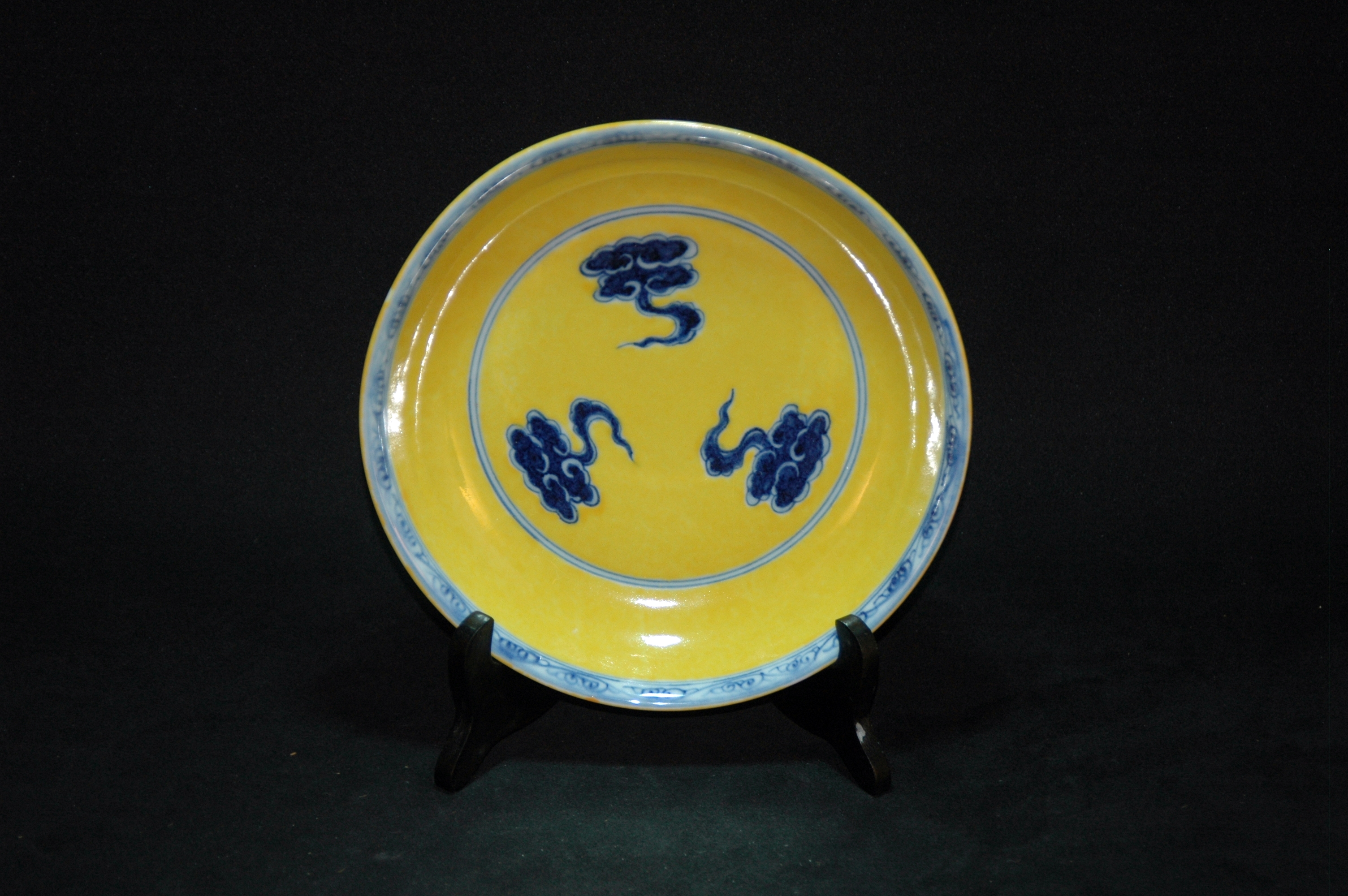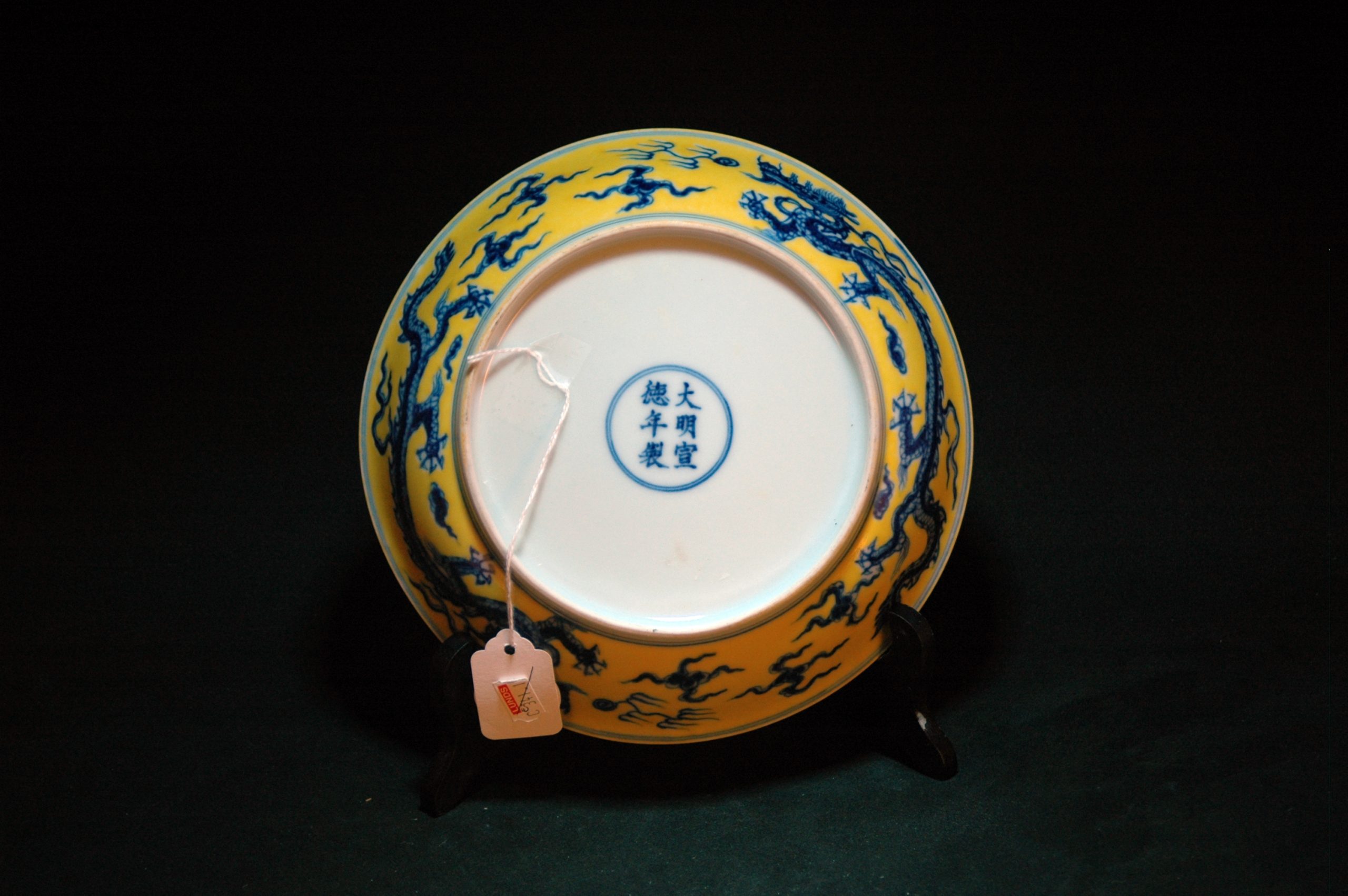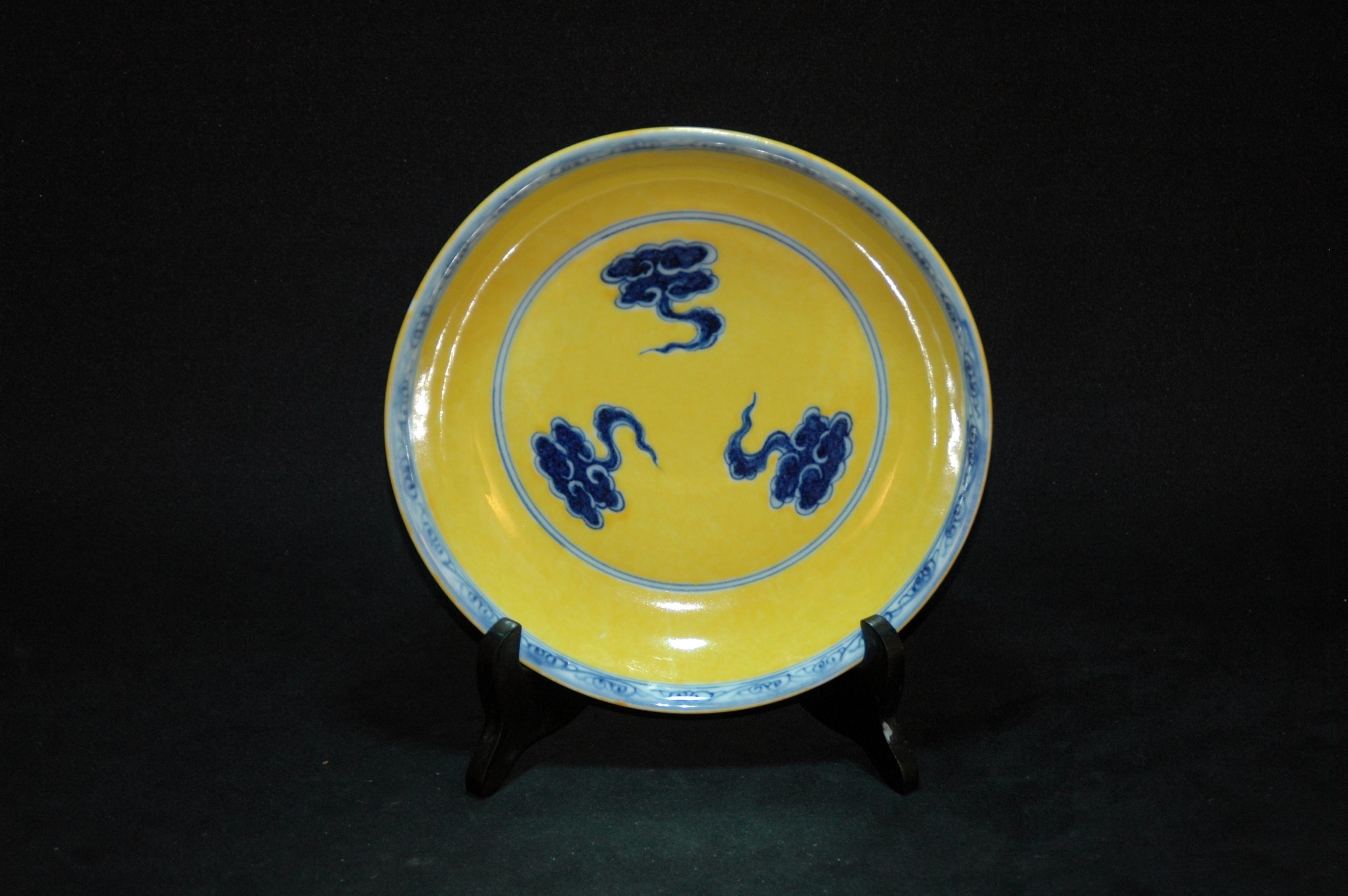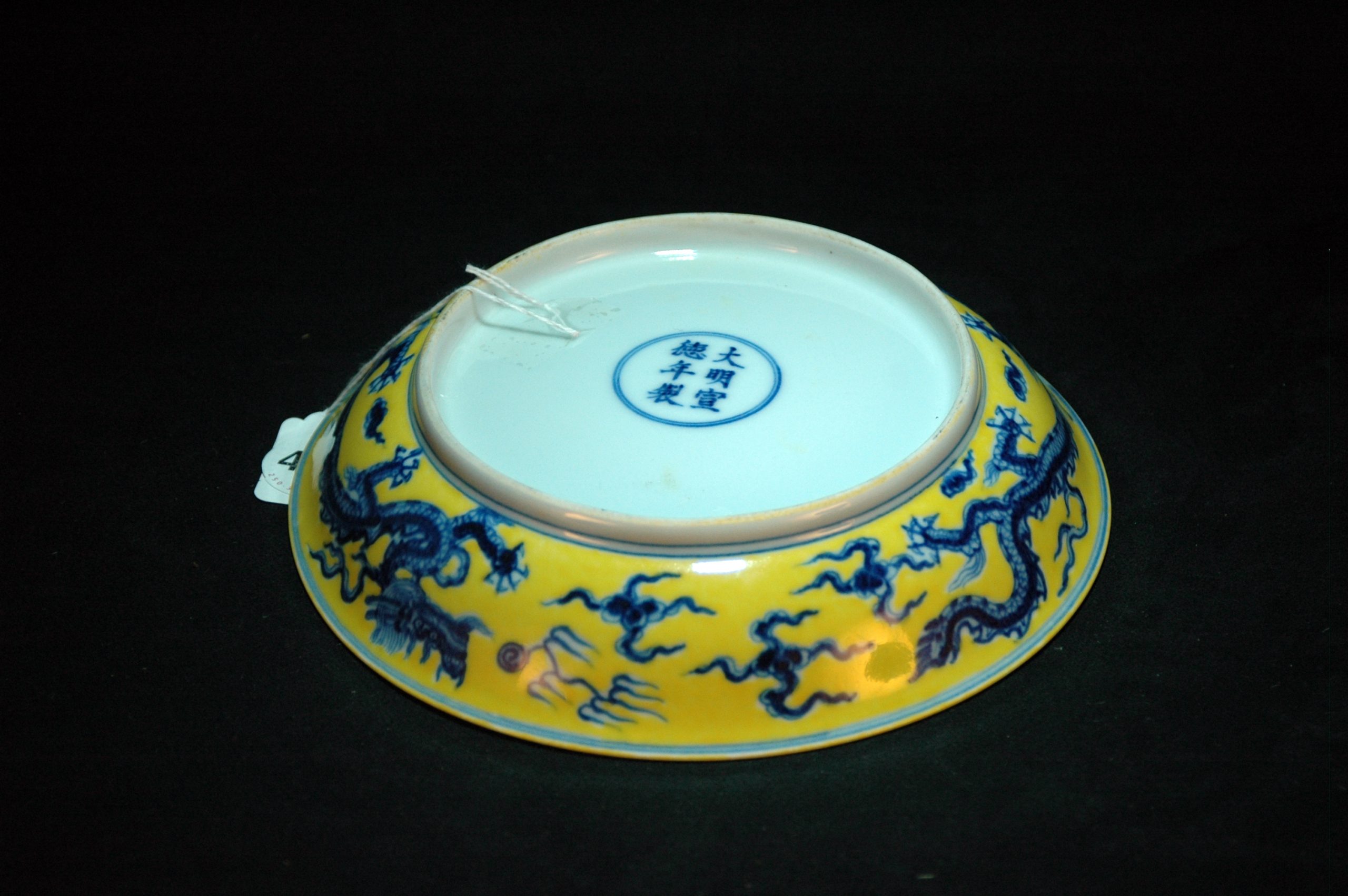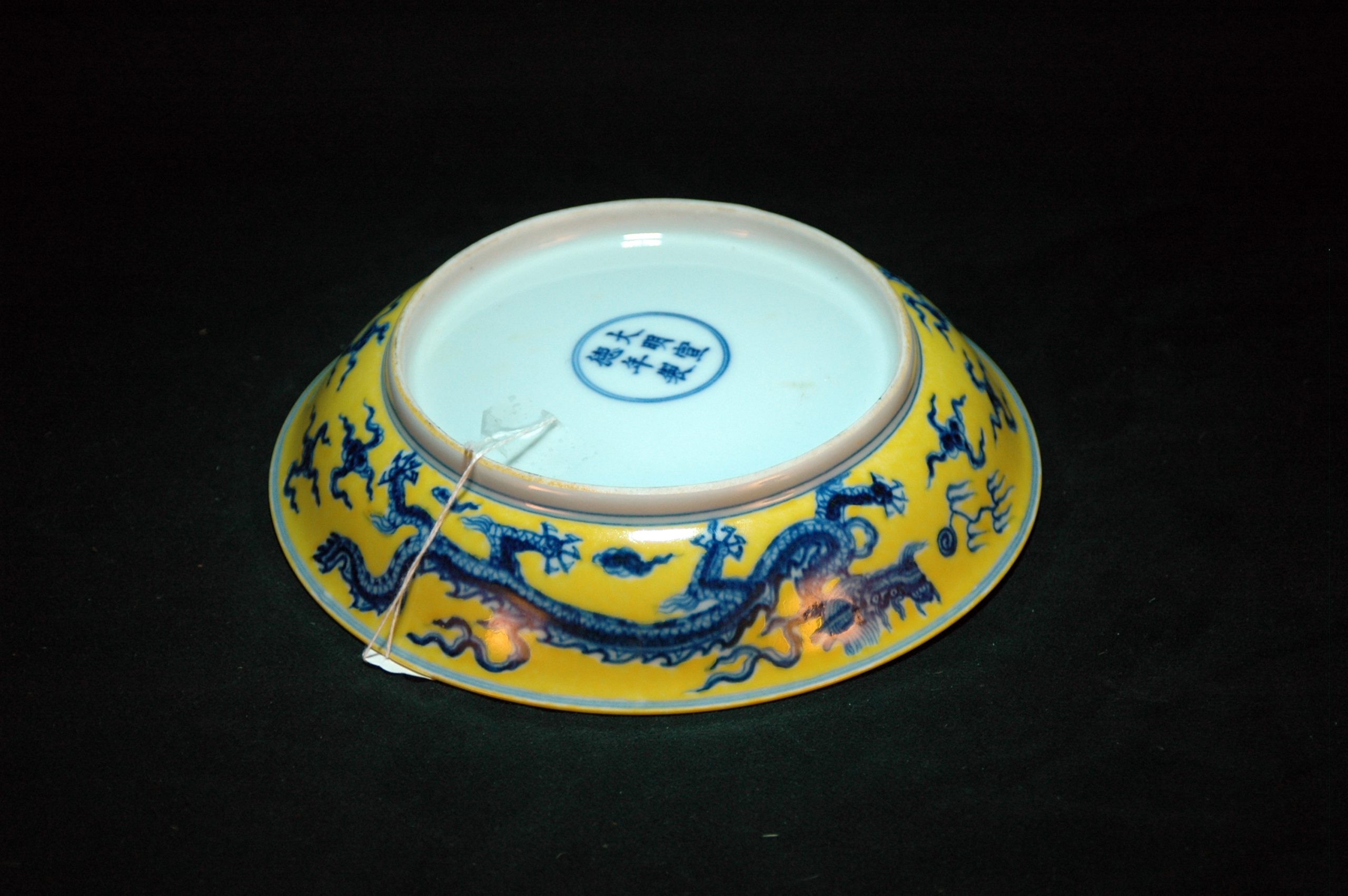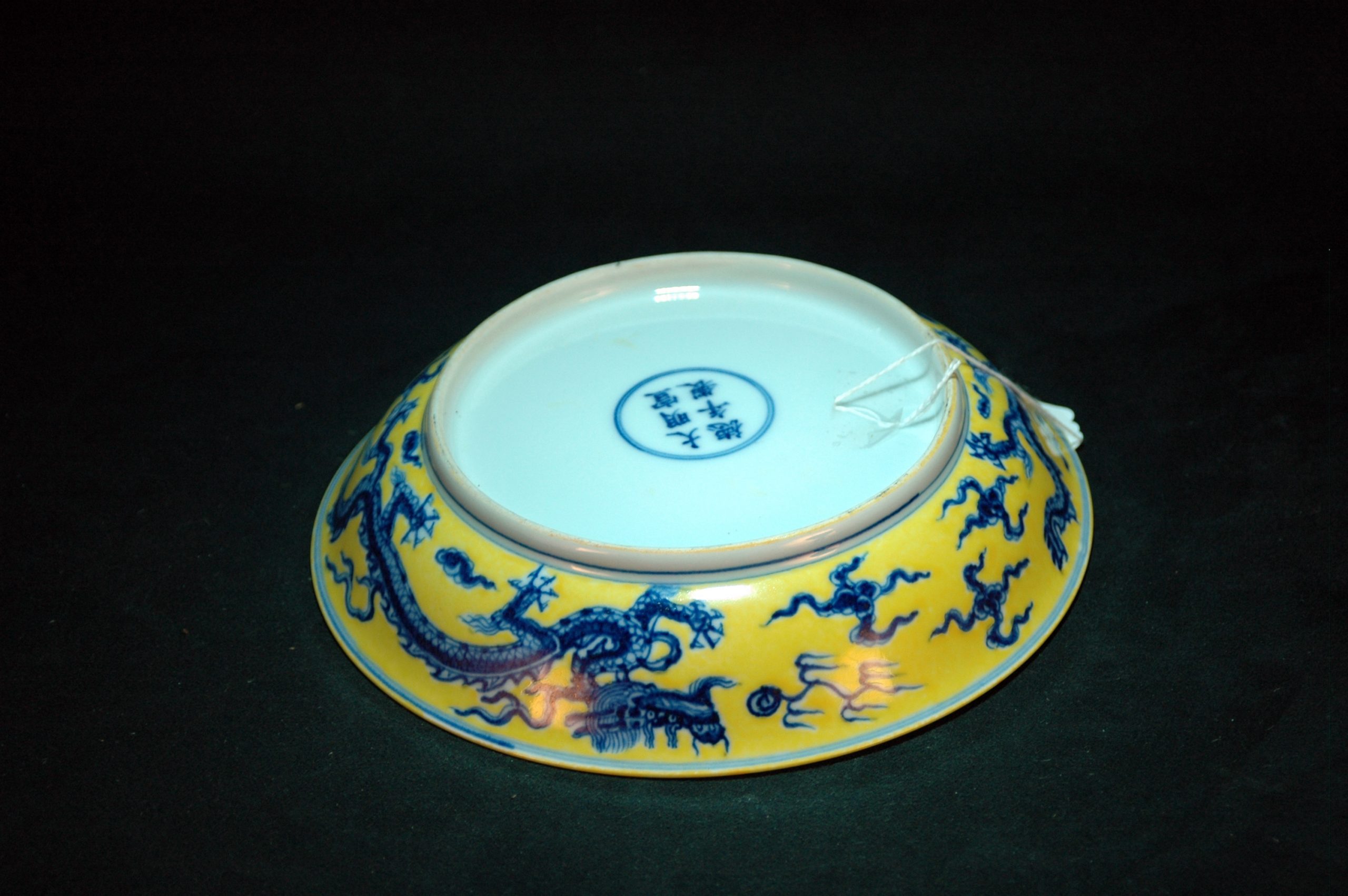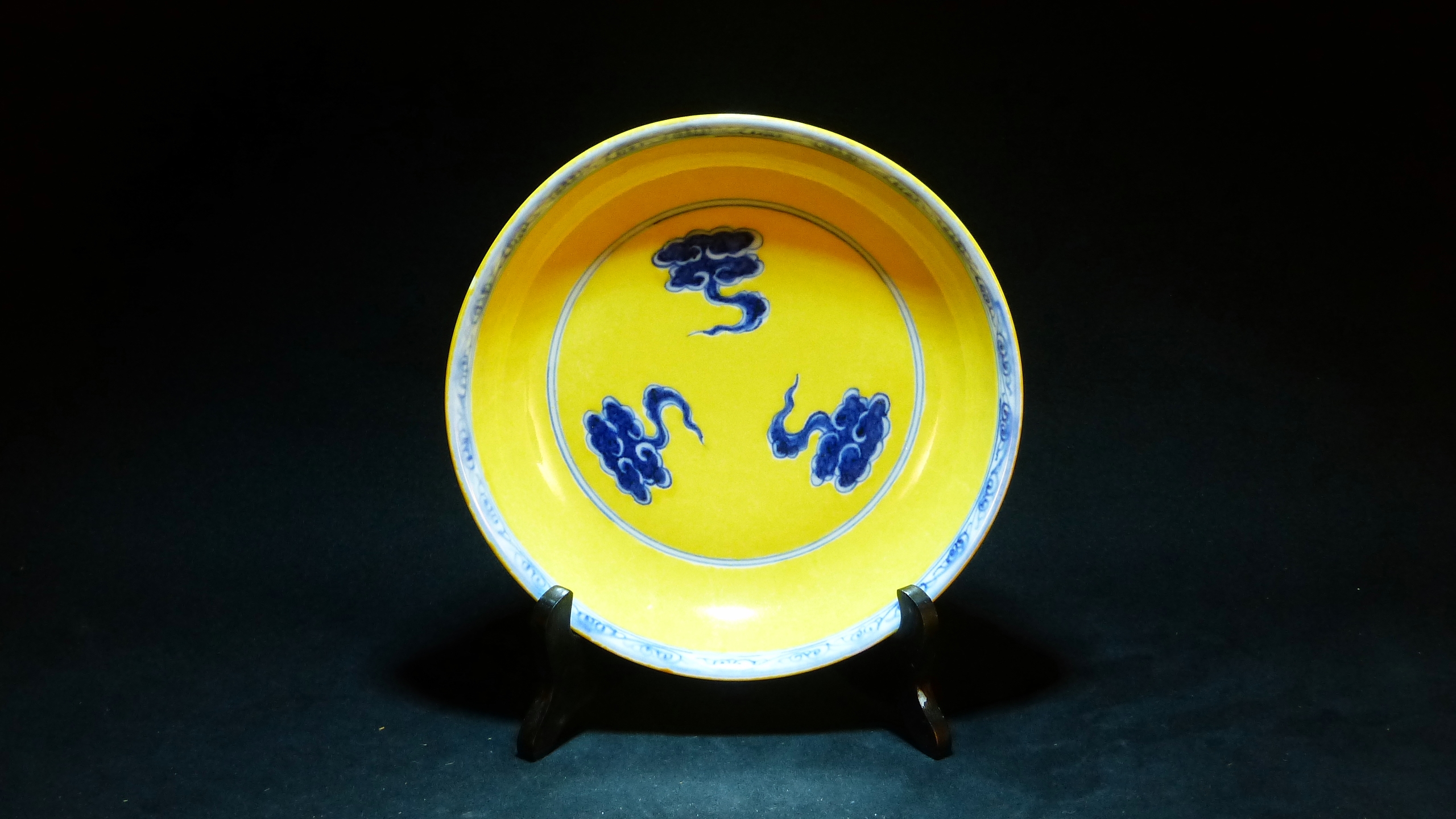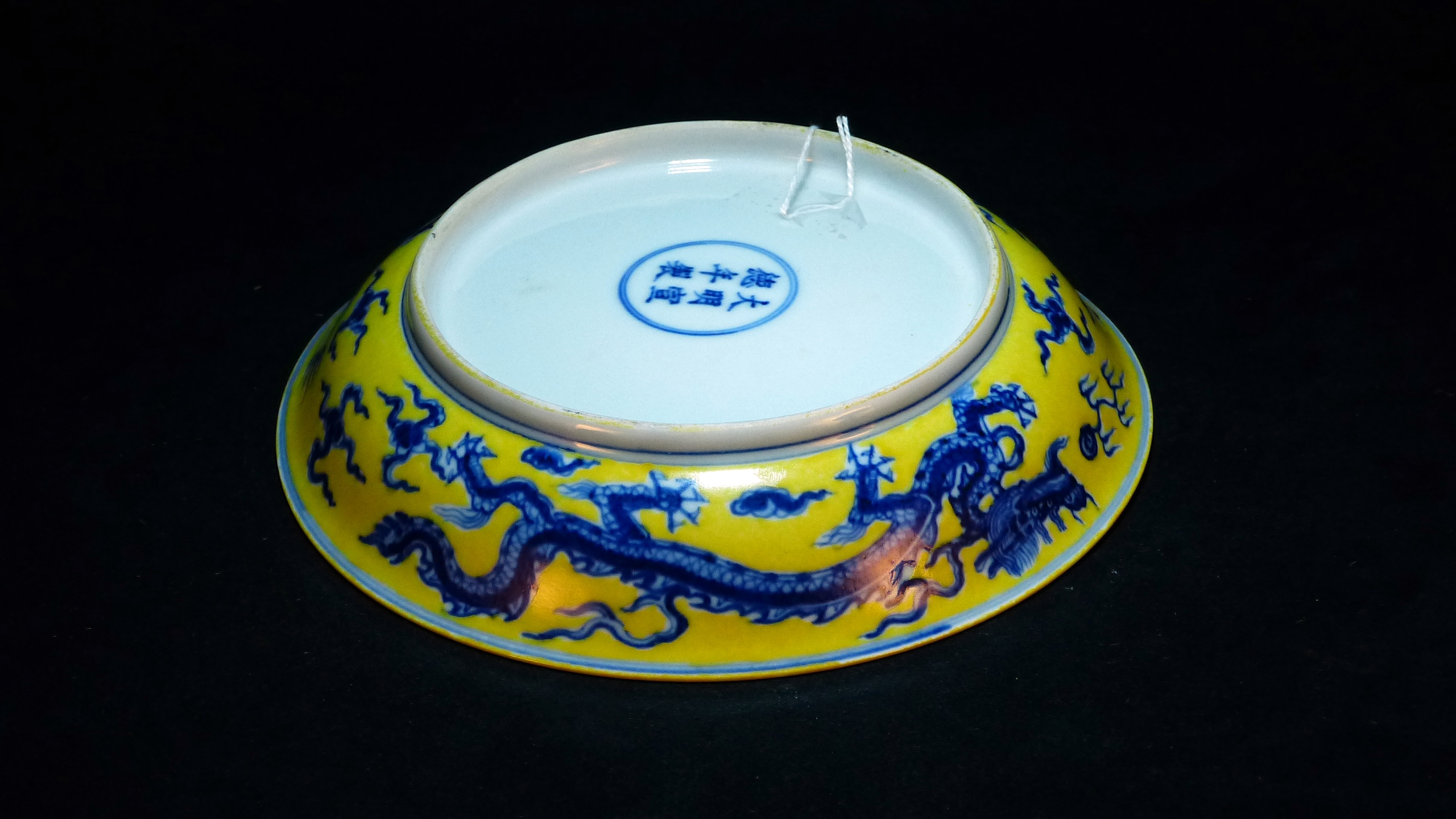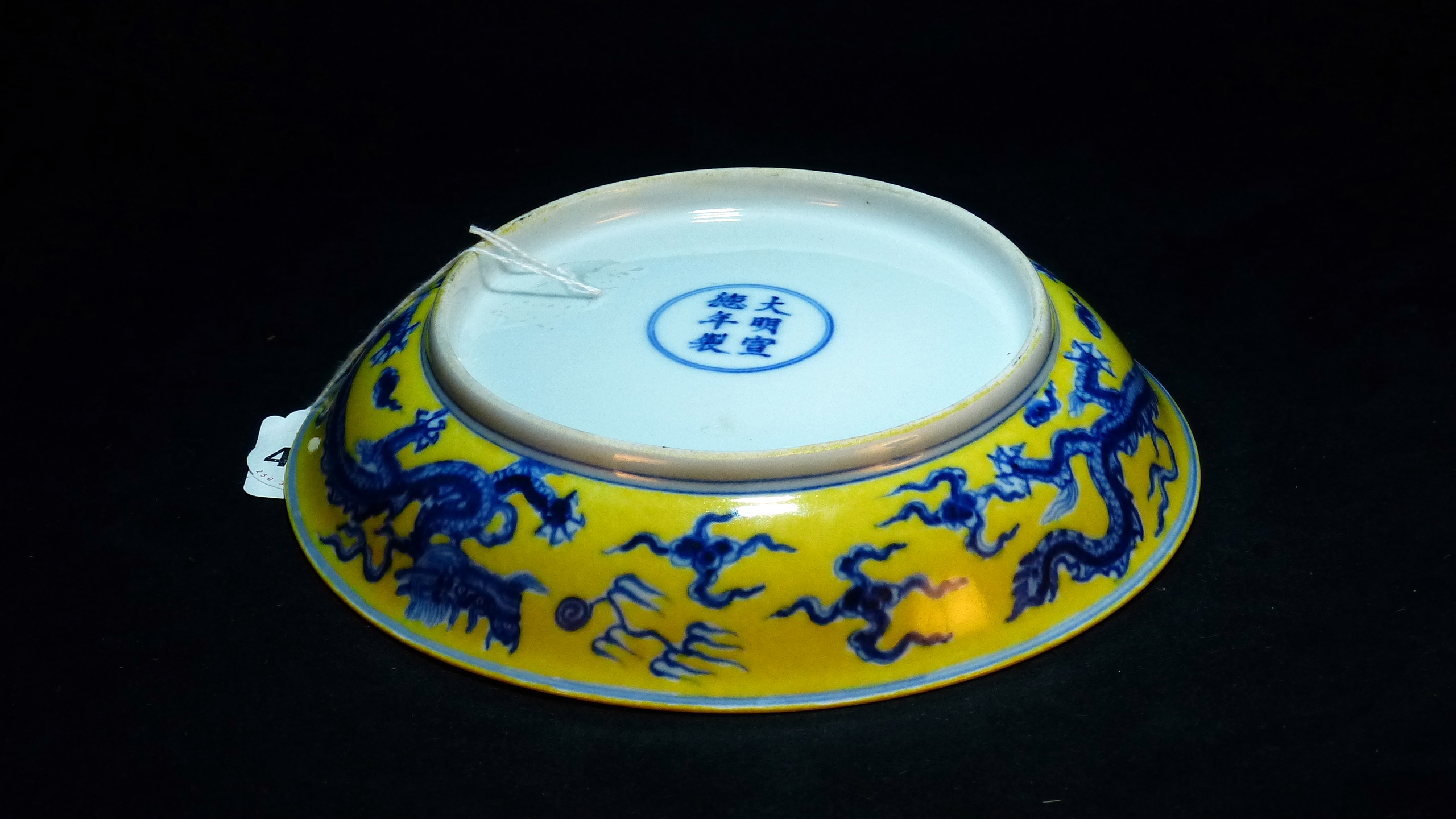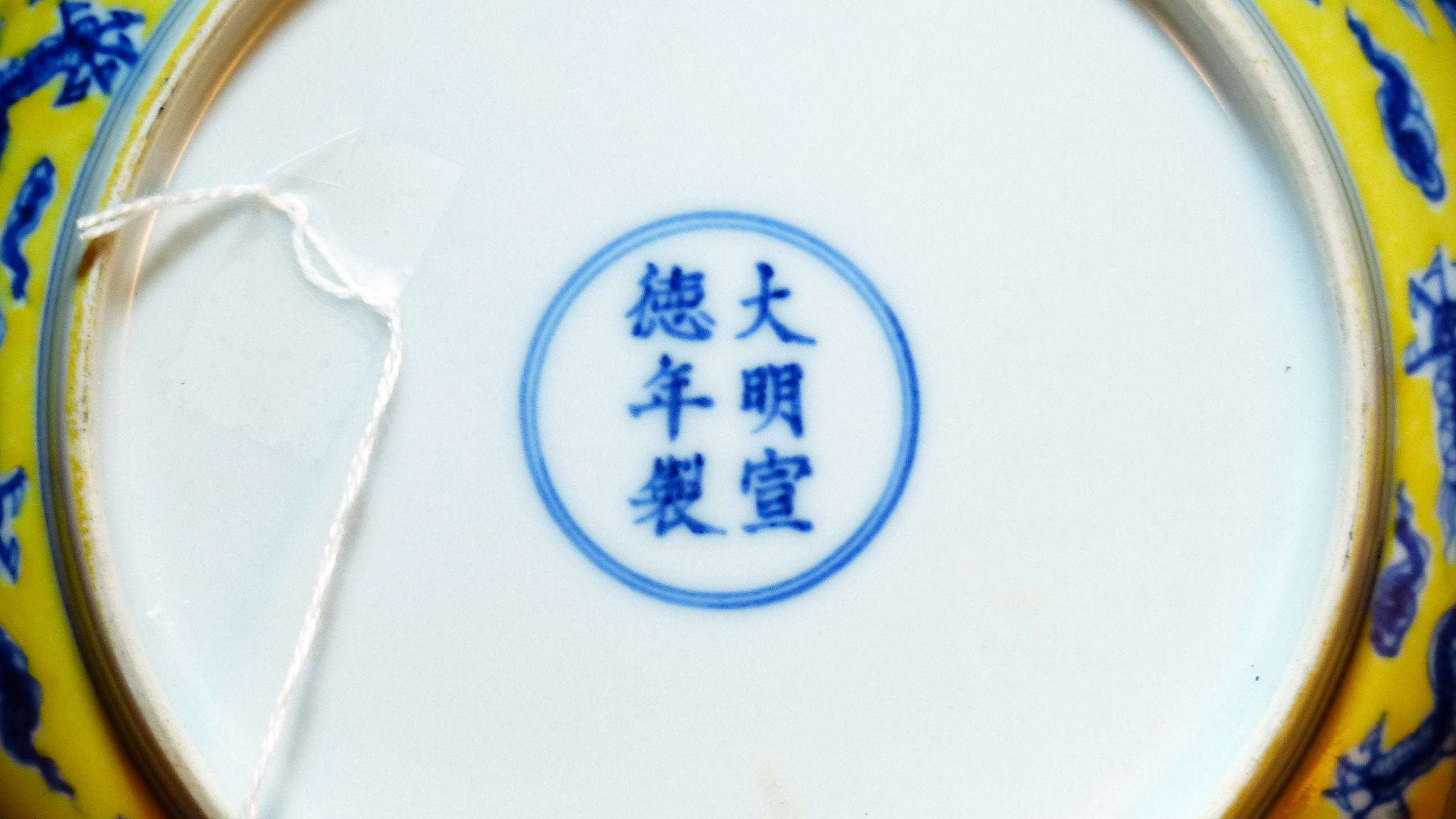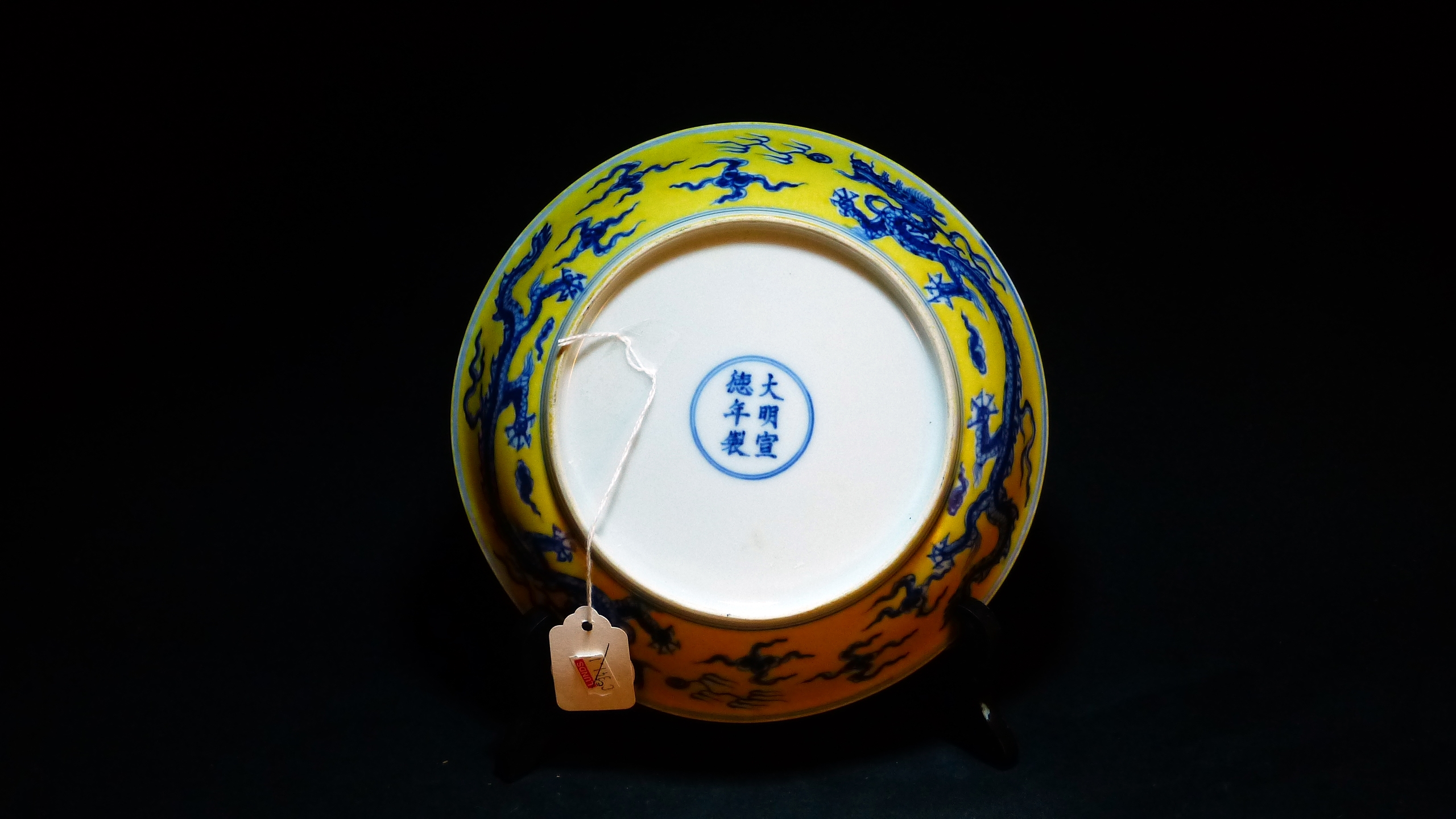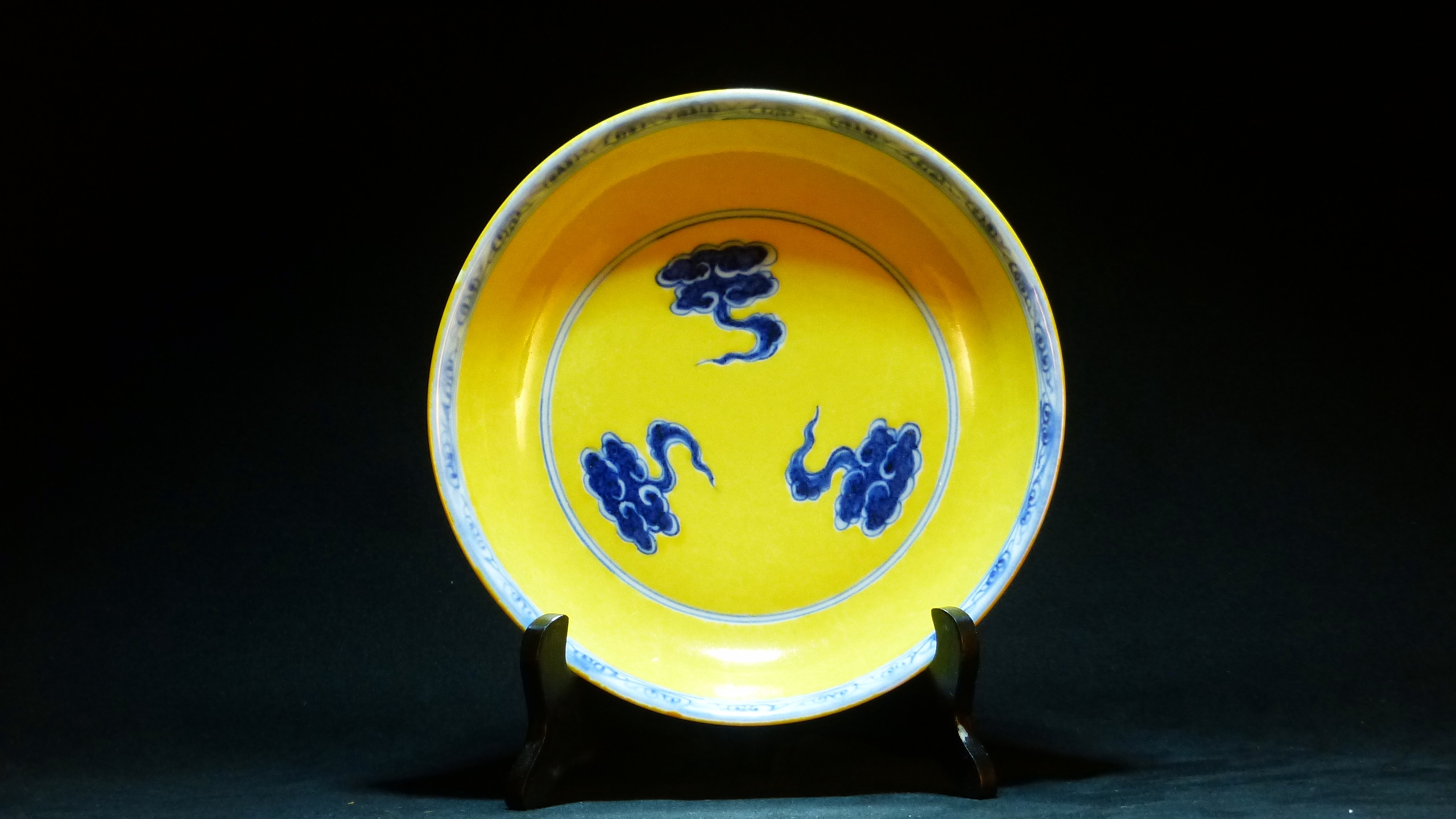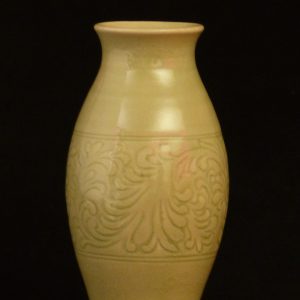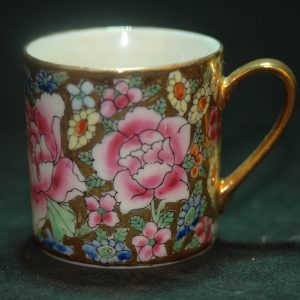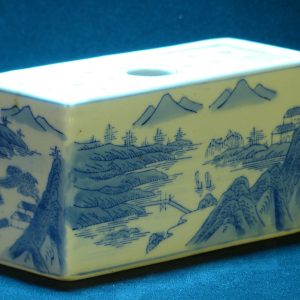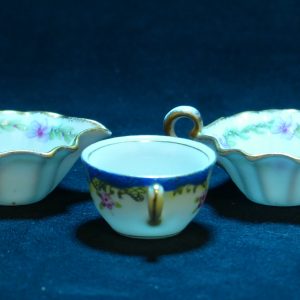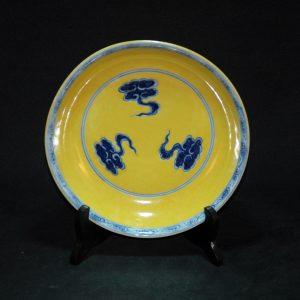Description
大明宣德款 黄地青花风卷如意云双龙纹盘
收购于拍卖行。外沿青花双龙赶珠 ,内沿青花三朵飘逸如意形云,明代典型装饰。
参考:苏富比
CHINA / 5000 YEARS
September 26, 08:52 AM PDT
Lot 1242. A blue and white ‘tri-cloud’ dish, Mark and period of Wanli
明萬曆 青花雲紋盤 《大明萬曆年製》款
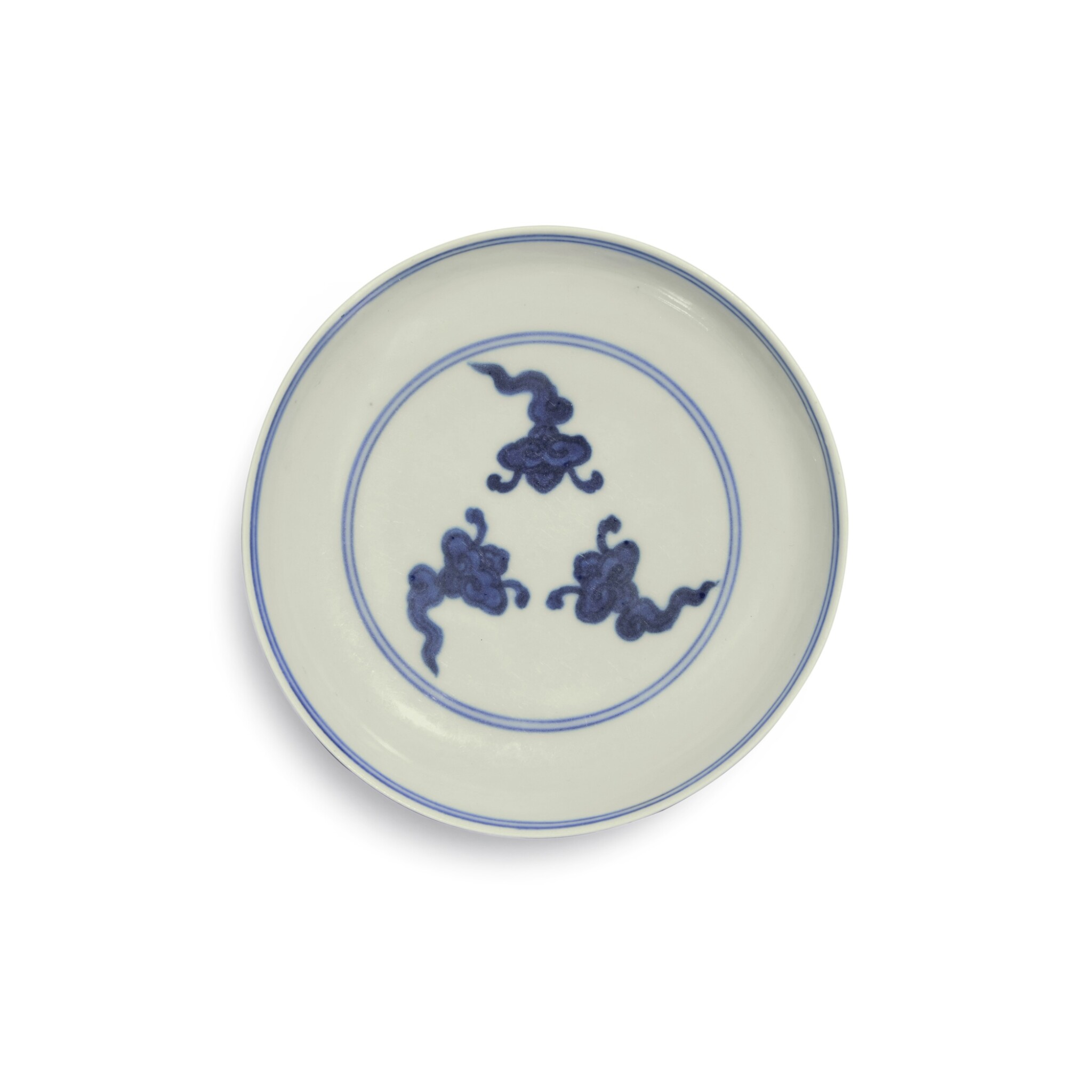
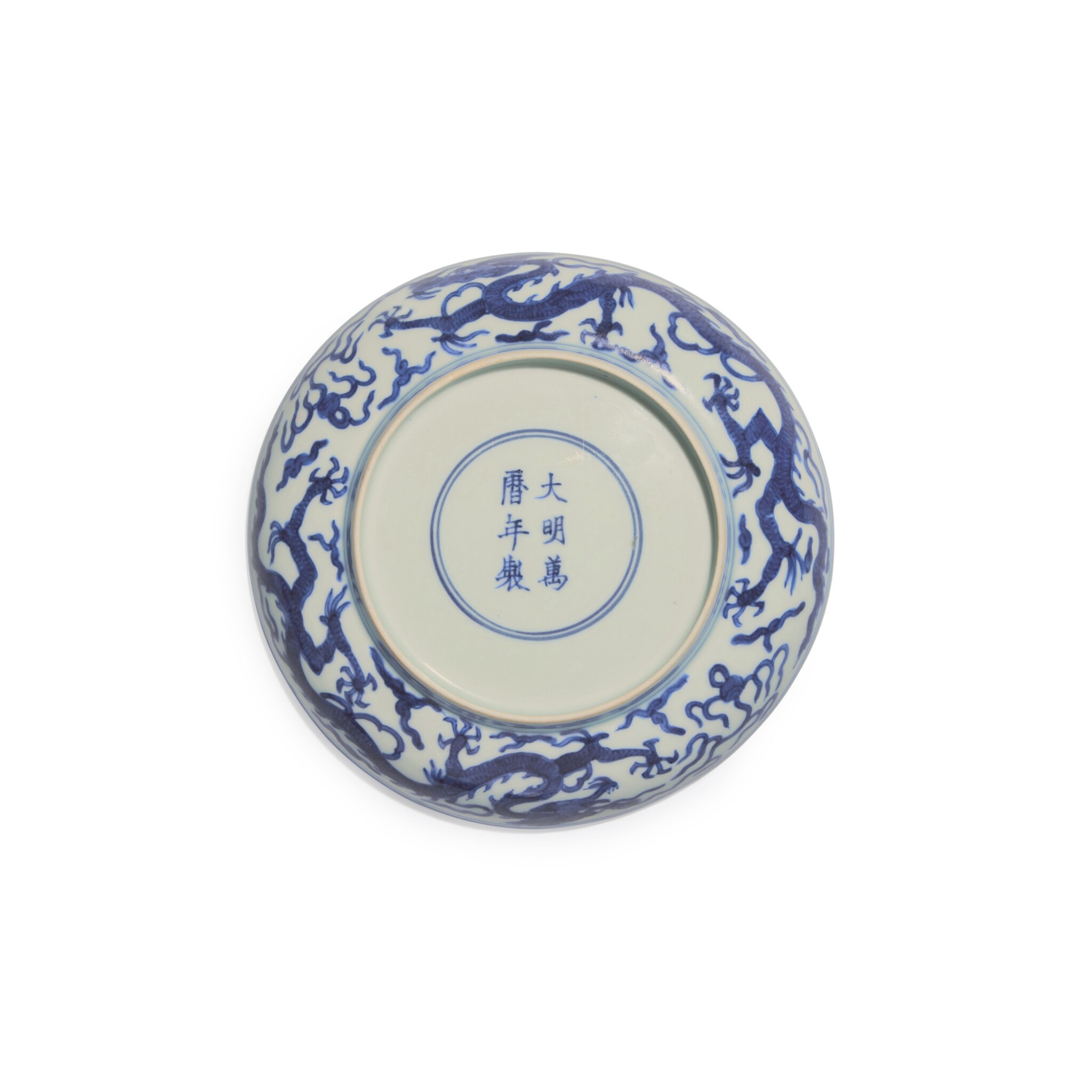
Estimate 8,000 – 12,000 USD
A blue and white ‘tri-cloud’ dish
Mark and period of Wanli
明萬曆 青花雲紋盤 《大明萬曆年製》款
the base with a six-character mark in underglaze blue within a double circle
Diameter 6⅝ in., 16.8 cm
Condition Report
The rim with a restored chip with an associated hairline, measuring 2.5 cm, and associated overspray. Overall with age-consistent wear and minor firing imperfections.
口沿見一小磕經修補,連帶一長約2.5公分細沖及噴釉。整體表面見正常磨損及少許微細窰燒瑕疵。
Provenance
Christie’s New York, 17th March 2017, lot 1186.
参考:香港蘇富比拍卖有限公司
1995年秋季拍卖会 1995-10-31
中国陶瓷、工艺品及玉器雕刻
LOT号:0384 明万历 内青花云外双龙赶珠纹盘

尺寸 17.5cm
估价 HKD 30,000-40,000
成交价 流拍
《大明万历年制》款
参考:苏富比 429
中國藝術品 包括趙從衍家族收藏藝術珍品
香港家族私人收藏
元 青花暗花穿雲游龍紋盤
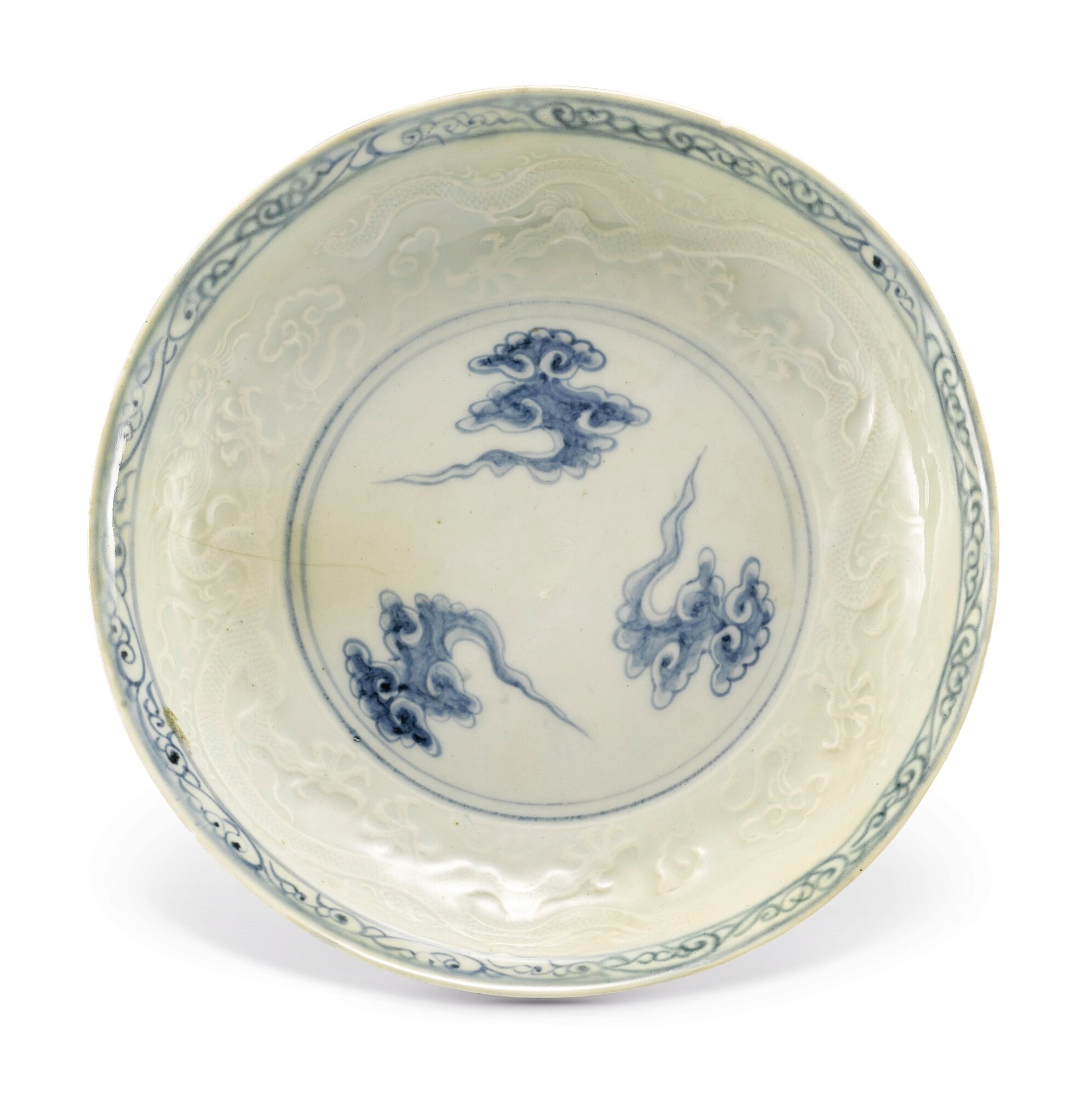
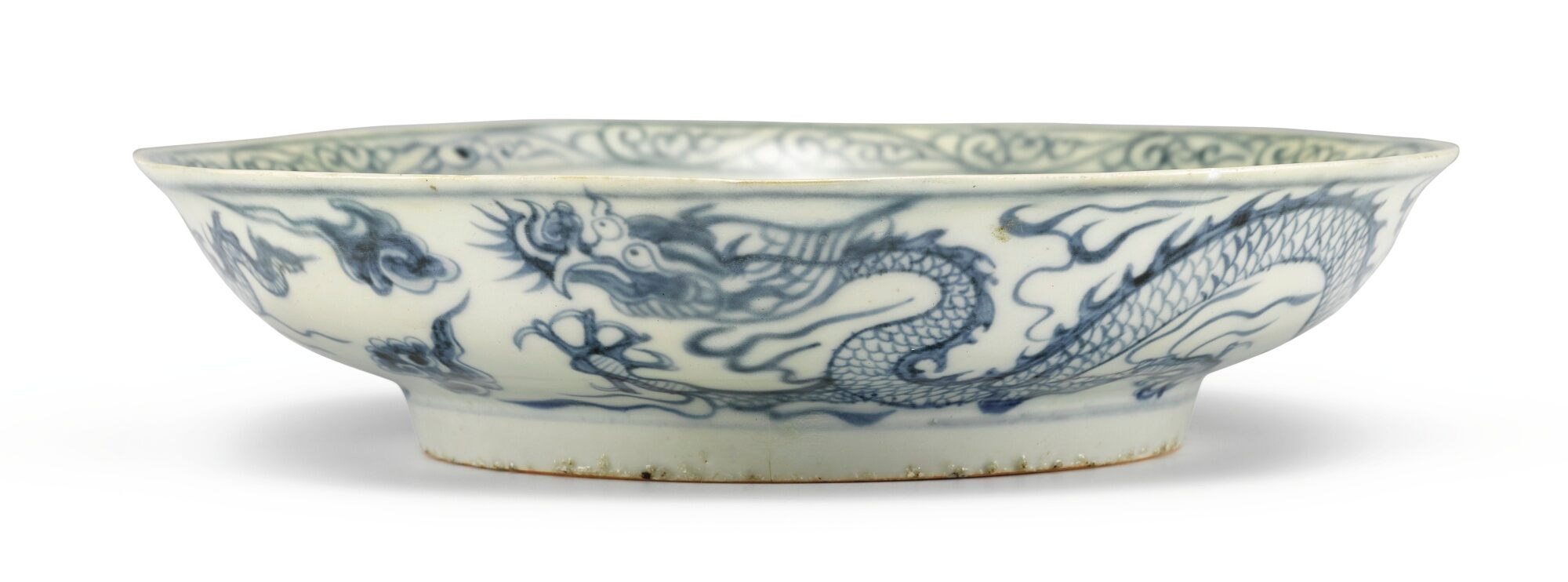
成交價 325,000 港幣 (含買家佣金)
40,000 — 60,000港幣
拍品詳情
元 青花暗花穿雲游龍紋盤
19.4 公分,7 5/8 英寸
來源
倫敦蘇富比1995年12月5日,編號382
中國藝術品 包括趙從衍家族收藏藝術珍品
2017年11月30日 – 2017年12月1日 | 下午 2:00 HKT
香港
参考:佳士得 拍賣 13982
中國瓷器及工藝精品
倫敦|2017年11月7日
拍品289|PROPERTY FROM A PRIVATE UK COLLECTION
清十九世紀 黃地青花螭龍纏枝花卉紋長頸瓶
來源: 英國私人珍藏, 倫敦邦翰斯1996年4月17日拍賣, 拍品16號
19TH CENTURY
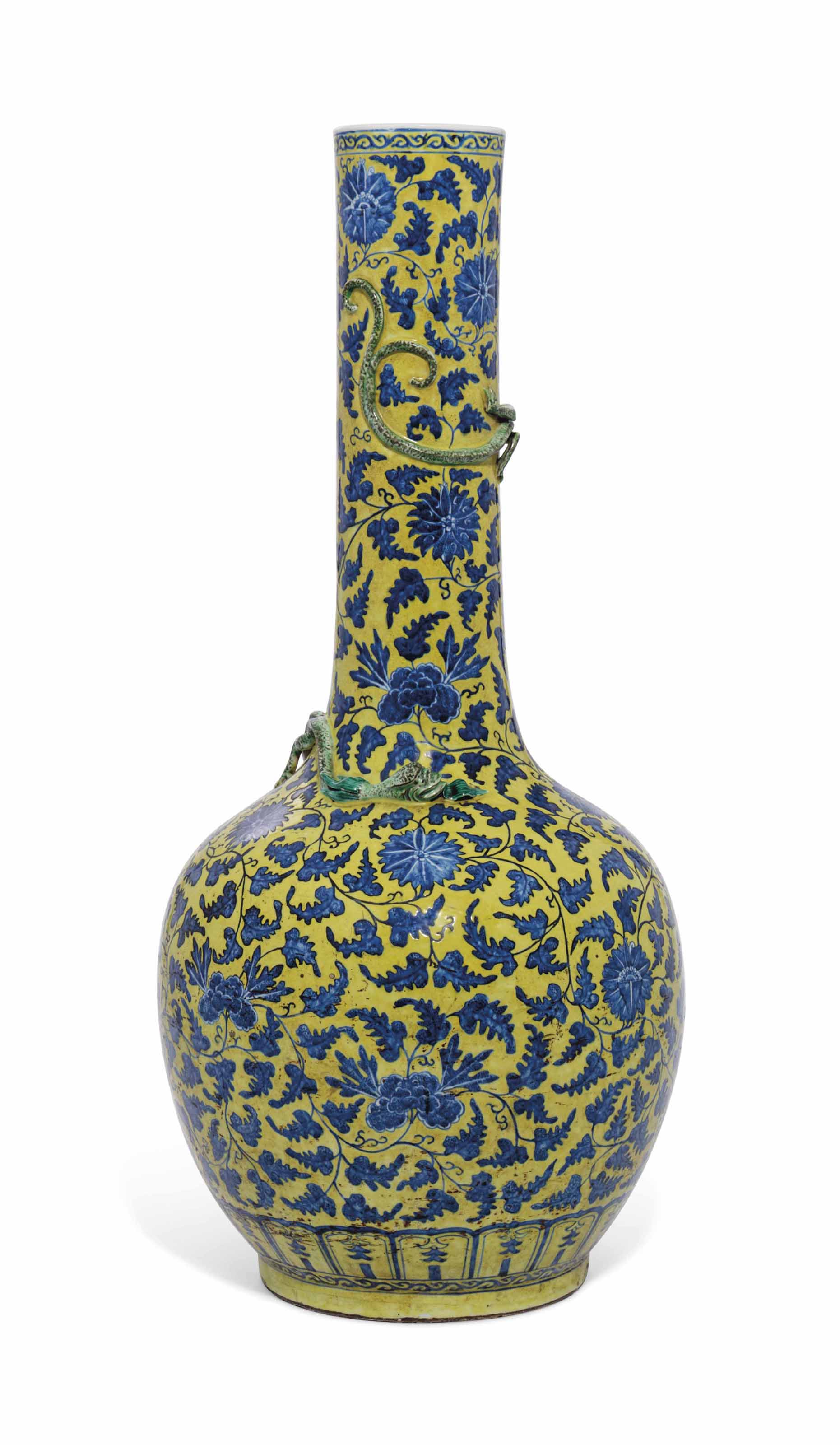
成交總額 GBP 11,250
估價 GBP 8,000 – GBP 12,000
清十九世紀 黃地青花螭龍纏枝花卉紋長頸瓶
來源: 英國私人珍藏, 倫敦邦翰斯1996年4月17日拍賣, 拍品16號
34 7/8 in. (88.5 cm.) high
來源
Bonhams London, 17 April 1996, lot 16.
参考:Sotheby’s苏富比
IMPORTANT CHINESE ART
3619 大清乾隆 青花矾红云龙纹梅瓶
A FINE AND MAGNIFICENT COBALT-BLUE AND IRON-RED ‘DRAGON’ VASE, MEIPING
SEAL MARK AND PERIOD OF QIANLONG
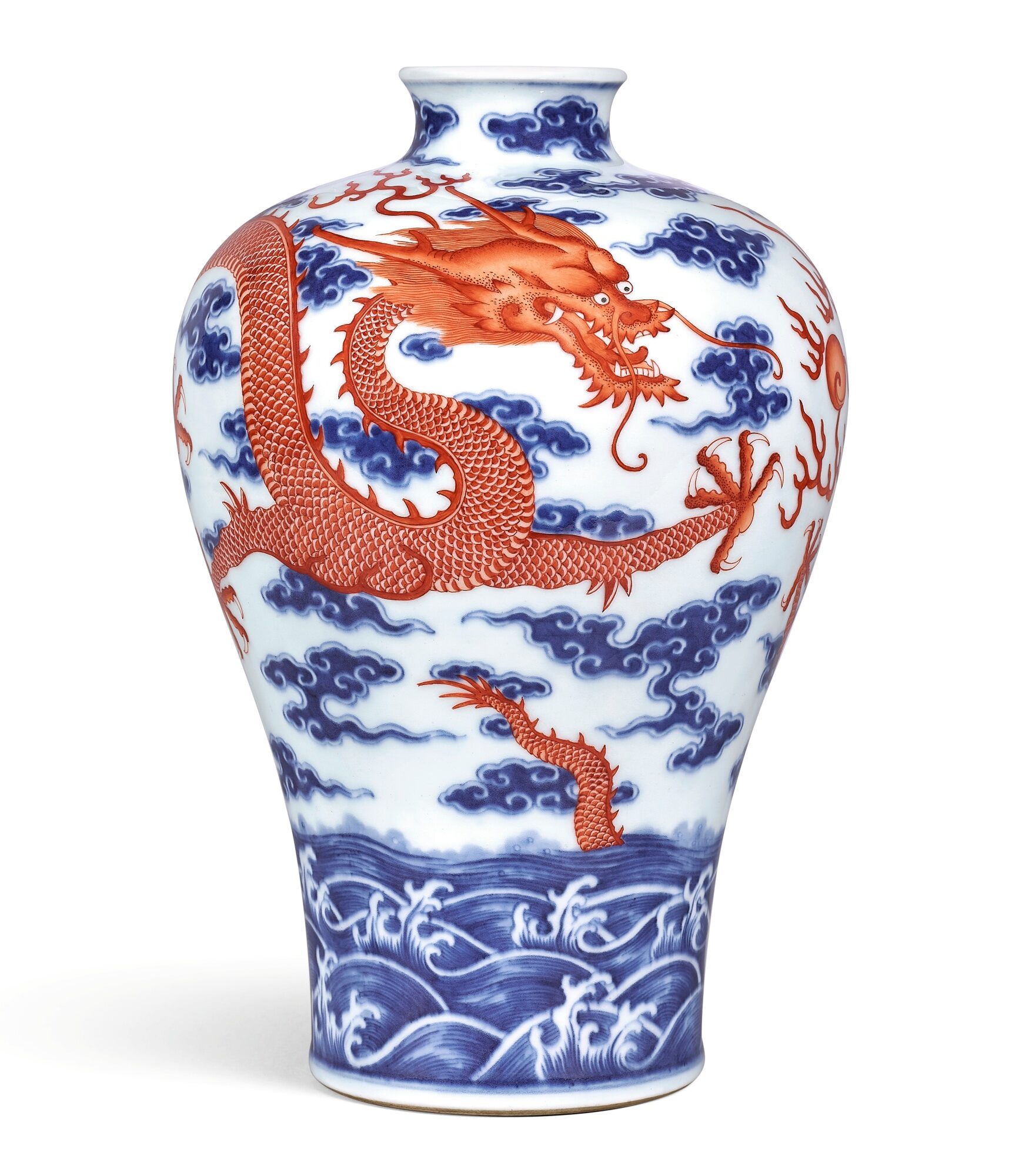
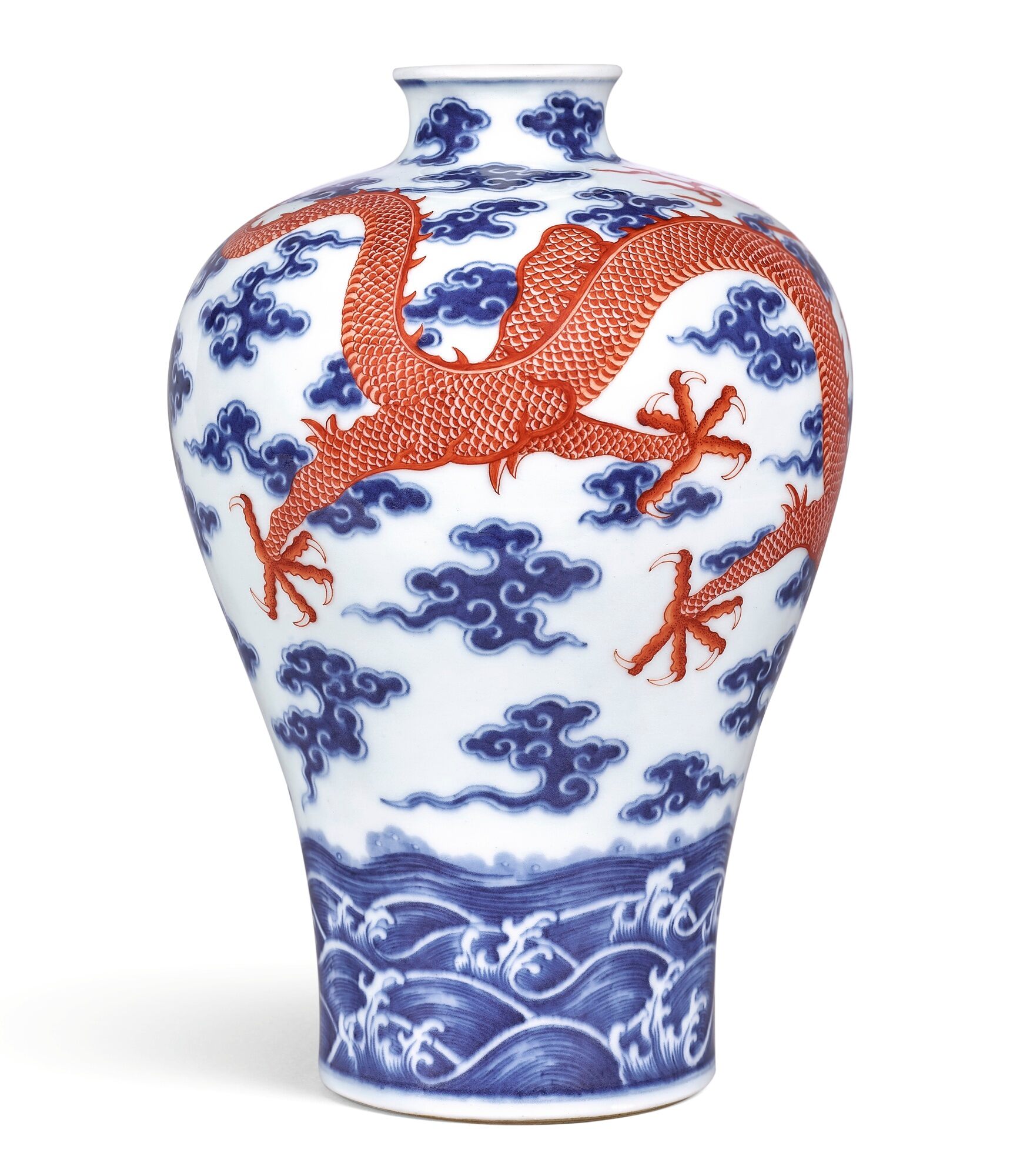
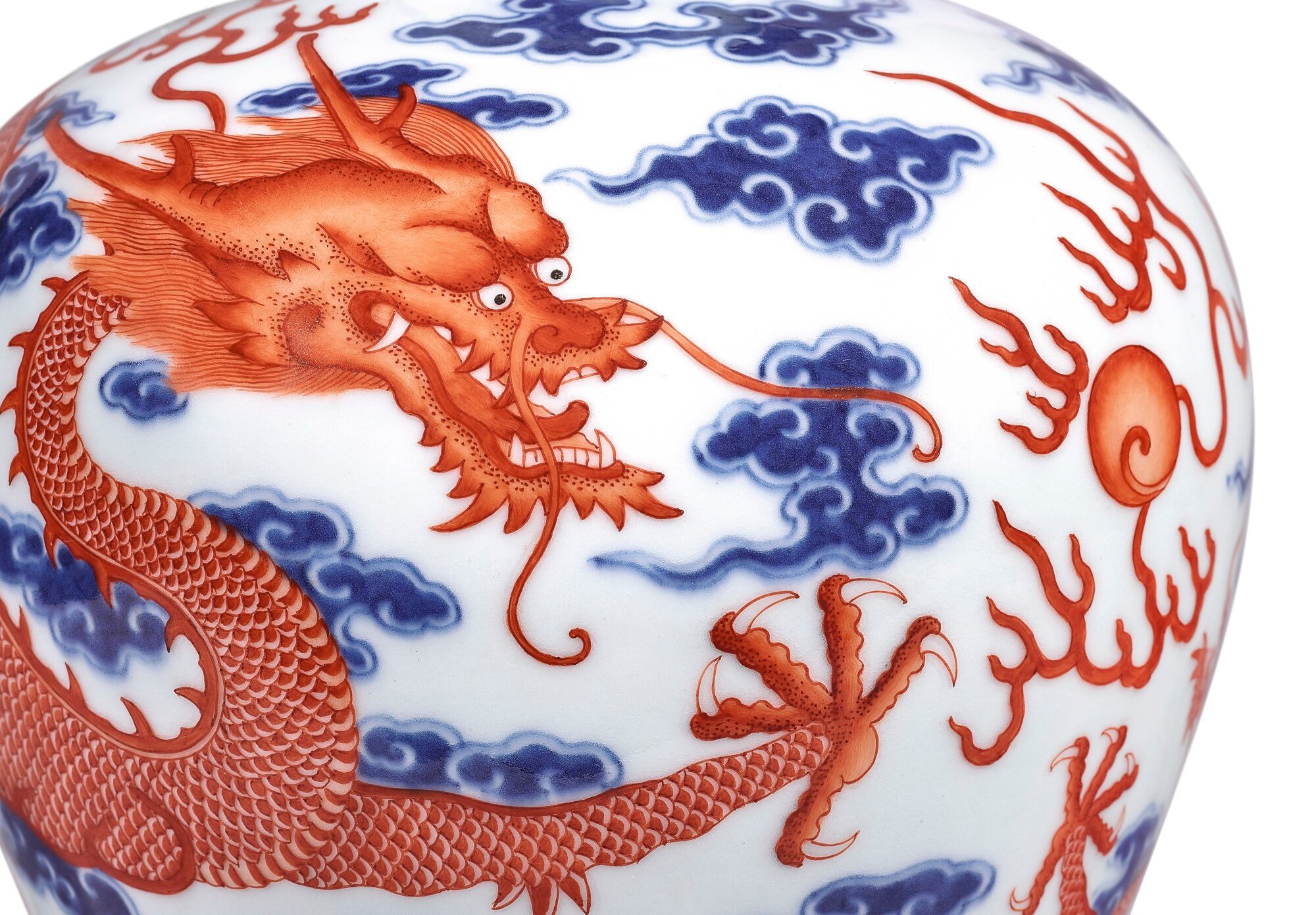

Estimate 18,000,000 — 25,000,000 HKD
LOT SOLD. 30,175,000 HKD
superbly potted with a tapering body sweeping up to a broad rounded shoulder surmounted by a waisted neck and everted rim, the exterior brilliantly enamelled in varying tones of iron red with two five-clawed dragons reaching for a central flaming pearl amidst flame wisps, one rendered larger and in a dominant position, portrayed writhing sinuously along the shoulder of the vessel, the other slightly subordinate and depicted with a more slender serpentine body with its tail emanating dynamically from the whirl-pool like waves bordering the lower body, each mythical beast skilfully rendered with a ferocious expression accentuated with piercing eyes and an open mouth revealing its teeth and tongue, the windswept mane and scales meticulously defined, all against a ground of cobalt-blue ruyi clouds, the recessed base inscribed with a six-character seal mark
27.4 cm, 10 3/4 in.
Condition Report
The vase is in overall extremely good condition with the enamels very well preserved, and just expected insignificant surface scratches.
PROVENANCE
A German private collection, by repute.
CATALOGUE NOTE
‘In Pursuit of Wisdom and Truth’ – A Magnificent ‘Dragon’ Meiping
Dr Hajni Elias
The present vase is exceptional for its elegant meiping form, flawless potting and impressive painterly decoration of two dragons, a larger and a smaller beast, writhing between clouds with mouths wide open and eyes intently gazing at the ‘precious pearl (baozhu)’ also known as the wish-granting or flaming pearl. The vase is a fine example of an imperial blue and white ware decorated with iron-red enamel over the glaze. The design of two dragons pursuing the luminous pearl is more familiar from contemporaneous textiles, especially costumes from the Manchu court, such as the jifu (semiformal robe) worn by the Qing emperors, that were intricately woven with renditions of the Chinese cosmic order of sky, water and earth with its many representative symbols. The adaptation of the motif to a meiping, such as the present vase, is less frequent. A better known version of the design depicts not two but nine five-clawed dragons, captured in varied poses amidst tumultuous rolling waves, painted in underglaze copper-red on a blue and white porcelain, as seen on a Yongzheng period (r. 1722-1735) meiping sold in these rooms, 7th May 2012, lot 579. The Yongzheng meiping possibly served as the blueprint for later, Qianlong period (r. 1735-1796) examples, a number of which may be found in museums and private collections. See a Qianlong mark and period meiping with the nine dragon design in the Palace Museum, Beijing, illustrated in The Complete Collection of Treasures of the Palace Museum: Blue and White Porcelain with Underglaze Red (III), Shanghai, 2000, pl. 205; and another in the Royal Ontario Museum, Toronto, is published in the T.T. Tsui Galleries of Chinese Art, Toronto, 1996, pl. 124. Another related

, is published in Kangxi. Yongzheng. Qianlong. Qing Porcelain from the Palace Museum Collection, Hong Kong, 1989, pl. 8 (fig. 1).
The accomplished use of the brush and masterful execution of every detail seen on the dragon figures, the attention paid to the their vivid facial expressions, their flowing mains and undulating scaly bodies, combined with the aesthetic richness of the background setting of clouds and waves, indicate aesthetic qualities associated with imperial masterpieces made for the Qianlong Emperor. To fully appreciate the importance of this striking vase it is helpful to understand the meaning and symbolism of its decoration. A large dragon in the company of a slender smaller dragon, usually facing each other, in the Chinese decorative repertoire suggest an older and younger dragon, possibly father and son, as expressed in the proverb ‘canglong jiaozi’ which translates as ‘the old dragon teaches his son’. For a detailed explanation of this motif see the essay on the turquoise-ground ‘dragon’ tianqiuping in this sale, lot 3614. However, the composition on this vase convey’s an additional important meaning to the well known ‘father and son’ subject matter, derived from the Daoist mythological tale of the two Azur Dragons (qinglong) being gifted the pearl of wisdom.1 The Chinese saying, ‘xuanglong qiangzhu’, which translates as ‘a pair of dragons contending over a pearl’ evokes this popular tale which may have served as the inspiration for the decoration on this vase.
According to the legend, while bathing in the Heavenly Lake (tianchi), a group of young immortal maidens were attacked by a bear-like creature. However, they were swiftly rescued by a pair of Azur Dragons (qinglong) who were engaged in the Daoist practice of ‘Cultivation and Transmutation (xiulian)’ in the waters of the lake.2 When the maidens told Xiwangmu, the Queen Mother of the West, what had happened, she rewarded the two dragons with a single pearl, the embodiment of spiritual essence and energy (also known as the qi) and the representation of wisdom and truth. The pearl was to help the dragons with their spiritual and physical xiulian practice. Although there was only one pearl to share between the two dragons, they did not fight or compete for it but went out of their way to make sure that the other benefited from the miraculous powers of the pearl. Thus the pearl, shining brightly, always floated rising and sinking between the two dragons.
The Jade Emperor (Yuwang Dadi) seeing the harmony created between the Azur Dragons, and their efforts at cultivating themselves, was so impressed and moved that he sent his minister, the Lord of the Great White Star (Taibaixing jun), with the gift of another pearl so that each dragon could have its own precious aid. The legend has an auspicious ending in which the two dragons eventually found the Way (Dao) and attained immortality. From then on, they helped people, bringing rain in times of drought and ensuring everyone was properly fed and clothed, and did not suffer any hardship. In gratitude and to show veneration, people erected shrines to celebrate and make offerings to the dragons. Thus the dragons came to be honoured and worshipped, becoming one of the most auspicious symbols in Chinese art. Bearing the above legend in mind, artisans working at the Imperial kilns at Jingdezhen under the tutelage of China’s most famous Superintendent Tang Ying (1682-1756), combined two inspirational sources, the father educating his son and the two together in pursuit of all the meritorious qualities represented by the pearl. The large dragon most likely represents the Qianlong emperor and the younger dragon his son, Prince Yongyan, the future Jiaqing Emperor (r. 1796-1820).
The symbolism of the pearl merits more discussion. At one level it represents spiritual energy and truth, this luminous object, usually rendered as a red or white sphere ringed by a fiery blaze, is also associated with the teachings of early Daoism where it represented the ‘sacred pearl of perception (yang energy)’. It is also a reference to the spiritual and physical cultivation of the body and soul (shen) which encapsulated the heart and mind (xin). The Chinese term translated as ‘mind’ uses the character ‘heart (xin)’, as in ancient times it was believed that the heart (and not the brain) functioned as the thinking organ that made judgements and was the seat of both affection and cognition.3 The pearl also became associated with the teachings of Buddhism, in its significance as representations of wisdom and enlightenment. In Chinese art the dragon is the ultimate symbol of imperial authority. Thus the dragon and the pearl together convey the idea of the emperor as the embodiment of the ultimate wisdom and truth. The message conveyed in the decoration of this vase is complex. Although the associations and meanings of the two dragons and the pearl would have been familiar to everyone, the maker of this vase has skilfully created a ‘new’ design using the above mentioned two popular sources.
While no other similar vase to the present piece appears to be recorded, see a miniature underglaze-red Qianlong mark and period meiping painted with two five-clawed dragons amidst clouds and bats, with one beast partially rising from crested waves, from the collection of W.W. Winkworth, sold in our London rooms, 12th December 1972, lot 102, and later in the collection of F. Gordon Morrill, New York, included in 1973 exhibition at the Museum of Fine Arts in Boston. Compare also a bottle form vase with a Qianlong reign mark and of the period, decorated in iron-red with a single large dragon reaching for a flaming pearl, sold in these rooms, 5th October 2016, lot 3302.
1 The Azur Dragon of the East is one of the Four Constellations that may be seen in the sky at night together with the Vermillion Bird of the South, the Black Turtle of the North and the White Tiger of the West. It symbolises protection and in ancient texts it has been reincarnated as famous warriors. It is also associated with the season of Spring and the Daoism element of Wood.
2 Xiulian is a type of Daoist neidan or esoteric physical, mental and spiritual practice to prolong life and create an immortal spiritual body.
3 See Roel Sterckx, Chinese Thought: From Confucius to Cook Ding, London, 2019, p. 169.
参考:佳士得拍賣 2152
重要中國瓷器及工藝精品
香港|2003年10月27日
拍品625|明 青花云盘
THE PROPERTY OF A FAR EASTERN GENTLEMAN
A FINE AND VERY RARE EARLY MING BLUE AND WHITE AND ANHUA-DEOCRATED ‘DRAGON’ DISH

成交總額 HKD 3,423,750
估價 HKD 1,600,000 – HKD 2,200,000
A FINE AND VERY RARE EARLY MING BLUE AND WHITE AND ANHUA-DEOCRATED ‘DRAGON’ DISH
YONGLE PERIOD (1403-1425)
The dish is finely potted with shallow curved sides rising to an everted rim and raised on a wedge-shaped foot, the exterior superbly painted in a rich tone of underglaze-blue with a lively design of two striding dragons pursuing ‘flaming pearls’ amidst scrolling clouds, the design repeated on the interior cavetto in anhua technique, surrounding the central medallion decorated with three detached cloud-scrolls, the mouth rim with a classic-scroll border
6 15/16 in. (17.6 cm.) diam., box
拍品專文
Previously sold at Sotheby’s Hong Kong, 5 November 1997, lot 1366.
Yongle dishes of this design are very rare. Only two examples have been published: one of slightly larger size, in the National Palace Museum, Taiwan, listed in Gugong Ciqi Lu, part II, vol. III, 1964, p. 98; and the other, from the Palace Museum, Beijing, is illustrated by Geng Baochang, Ming Qing Ciqi Jianding, Hong Kong, 1993, fig. 7, together with a Hongwu prototype of this pattern, fig. 6.
The three-cloud decoration on the central medallion appears on early Ming dishes from as early as the Hongwu period. Geng Baochang provides line drawings of the different styles of the same design during the Hongwu, Yongle, Xuande, Zhengde and Wanli reigns, ibid., p. 17, fig. 22. Compare the present lot to a blue and white dish with comparable design of clouds and anhua dragons on the interior, dated to about 1400, and from the collection of Mrs Alfred Clark, illustrated by S. Jenyns, Ming Pottery and Porcelain, London, 1953, pl. 24A. Cf. also a Yongle dish similarly decorated on the inside, but with two moulded phoenix around the cavetto and phoenix and clouds on the exterior, recovered from the excavation site of the Ming imperial kilns at Zhushan, included in the 1996 Chang Foundation exhibition Imperial Hongwu and Yongle Porcelain Excavated at Jingdezhen, illustrated in the Catalogue, no. 49.
A Xuande version of this design from the collections of Major Lindsay F. Hay, Frederick M. Mayer and T. Y. Chao, was included in the exhibition Ming and Ch’ing Porcelain from the Collection of the T. Y. Chao Family Foundation, Hong Kong Museum of Art, 1978, illustrated in the Catalogue, no. 15.
編製圖錄及詳情
拍品前備註
THE PROPERTY OF A FAR EASTERN GENTLEMAN
参考:佳士得拍賣 2811
中國宮廷御製藝術精品、重要中國瓷器及工藝精品
Hong Kong|2010年5月31日
拍品1988 明正德 青花朵雲龍紋盤 雙圈雙行六字楷書款
THE PROPERTY OF A FAR EASTERN COLLECTOR
A RARE MING BLUE AND WHITE SAUCER-DISH
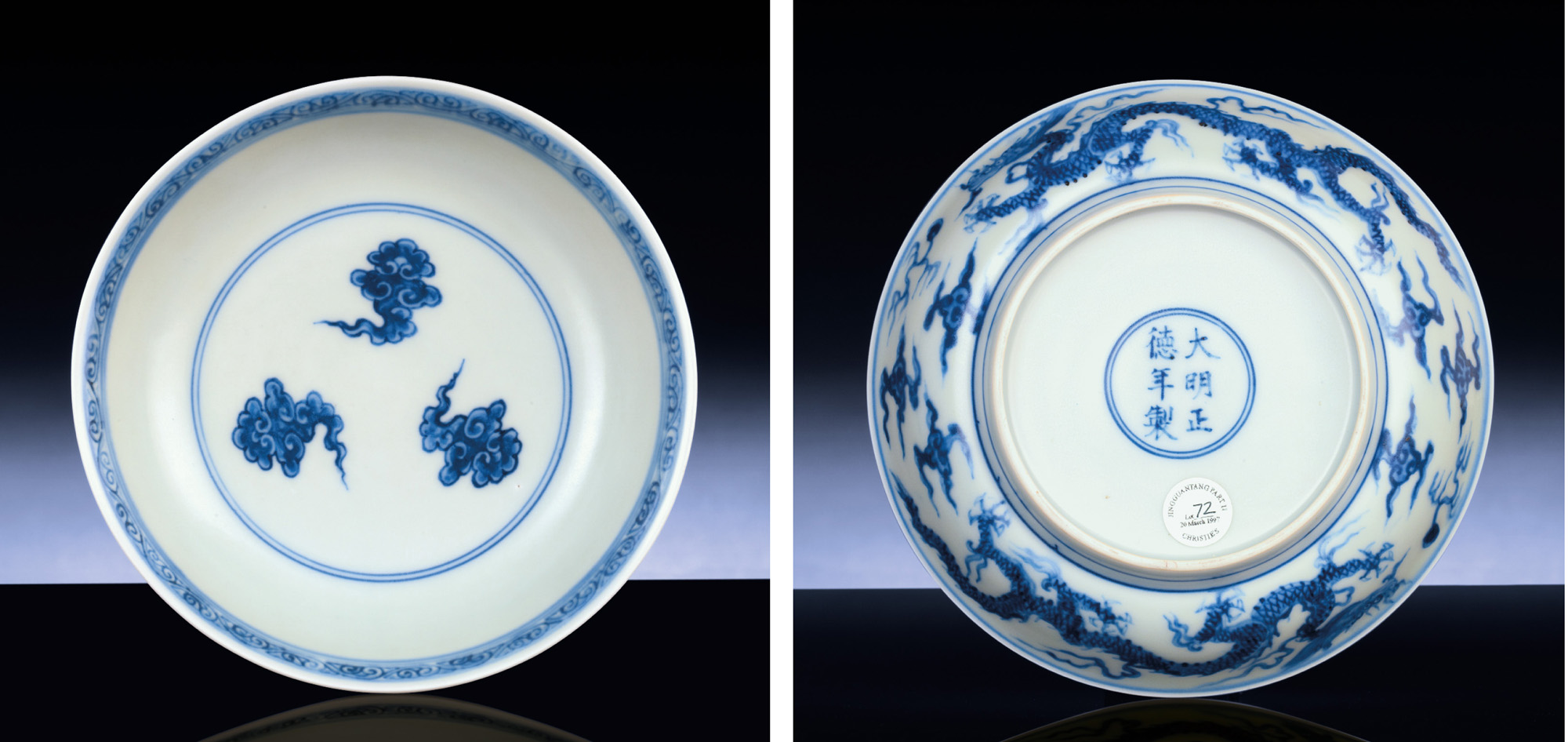
成交總額 HKD 500,000
估價 HKD 350,000 – HKD 450,000
此罐源自靜觀堂收藏,1992年及1997年分別於星加坡和香港大學展出,1997年3月20日於紐約佳士得靜觀堂專拍中拍出,拍品72號。
來源
The Jingguantang Collection Part II, sold at Christie’s New York, 20 March 1997, lot 72
狀況報告
– The surface has been polished to the interior and exterior, however signs of wear are still visible.
– One or two minor glaze frits to the rim some of which have been infilled.
文獻及展覽
展覽
Gems of Chinese Art, The Empress Place Museum, Singapore, 1992, no. 82
拍品專文
Slightly larger dishes of this design with Zhengde marks include the one illustrated by R. Krahl, Chinese Ceramics from the Meiyintang Collection, vol. 2, London, 1994, p. 74, no. 687; another illustrated in Porcelains from the Tianjin Municipal Museum, Hong Kong, 1993, nos. 105 and 106; and one in the National Palace Museum, Taiwan, illustrated in the Blue and White Wares of the Ming Dynasty, Book IV, Hong Kong, 1968, pl. 11.
For a discussion of the origins of this design, see R. Krahl, op. cit., p. 74. A Xuande-marked dish of this pattern was included in the exhibition, Blue-Decorated Porcelain of the Ming Dynasty, Philadelphia Museum of Art, October 29 – December 4, 1949, and illustrated in the Catalogue, no. 65.
THE PROPERTY OF A FAR EASTERN COLLECTOR
参考: 拍卖结果
香港苏富比2017年11月拍卖会
中国艺术品 包括赵从衍家族收藏艺术珍品
元 青花暗花穿云游龙纹盘


估价:40,000-60,000 HKD
成交价: 325,000 HKD (含买家佣金)
尺寸:19.4 cm
拍品说明:
来源: 伦敦苏富比1995年12月5日,编号382
参考:巴黎苏富比2017春季拍卖会
亚洲艺术
明万历 青花灵芝纹盘 《大明万历年制》款
亞洲藝術
2017年6月22日 | 上午 10:30 CEST
巴黎

拍卖信息
Lot 142 明万历 青花灵芝纹盘 《大明万历年制》款

拍卖信息
Lot 142 明万历 青花灵芝纹盘 《大明万历年制》款

拍卖信息
Lot 142 明万历 青花灵芝纹盘 《大明万历年制》款
估价:20,000-30,000 EUR
未成交
尺寸:17.6cm
器形微歪。口沿見釉面毛口。盤心釉面見輕微使用痕跡。內壁及底部見針孔形釉面瑕疵。
参考:北京保利2015春季拍卖会 > 中国古董珍玩(Ⅰ) > 清乾隆 青花釉里红云蝠纹盘

拍卖信息
Lot 8801 清乾隆 青花釉里红云蝠纹盘
估价:40,000-60,000 RMB
未成交
尺寸:直径27.5cm
参考:北京保利2016年春季拍卖会
中国古董珍玩(Ⅰ)
明万历 青花外龙纹内云纹盘
估价:60,000-80,000 RMB
尺寸: 直径16.2cm
拍品说明:
“大明万历年制”款

参考:北京保利2016年春季拍卖会
中国古董珍玩(Ⅰ)
清康熙 黄地青花龙纹福寿小碗

估价:80,000-120,000 RMB
未成交
尺寸:直径11.4cm
拍品说明:
“大清康熙年制”款 拍品敞口,弧腹,圈足,形制周正。碗通体以青花描绘纹饰,碗内底心于双圈内绘一腾跃于云中之立龙,流云环绕,呈龙游九天之盛况。外壁底心留“大清康熙年制”双圈六字二行楷书款,近足处绘重瓣莲花,其上通景绘制二行龙驰骋于云间,其龙身姿矫健,五爪刚劲,威风凛凛。二龙首尾之间各点缀灵芝一株,其上饰如意形牌,分别书写“福”、“寿”二字。整器造型端正,胎体轻薄,釉层紧密,图案繁狡,绘制精细,色彩绚烂,雍容堂皇,展示了康熙时期制瓷工艺的高超水平。
参阅:
《宫廷珍藏中国清代官窑瓷器》,上海文化出版社,2003年,页71
《上海博物馆藏康熙瓷图录》,上海博物馆、两木出版社,1998年,页26,图18
参考相似拍品
北京保利国际拍卖有限公司
北京保利十二周年秋季拍卖会2017-12-19
大明·格古
6058 明正德 青花朵云双龙纹盘
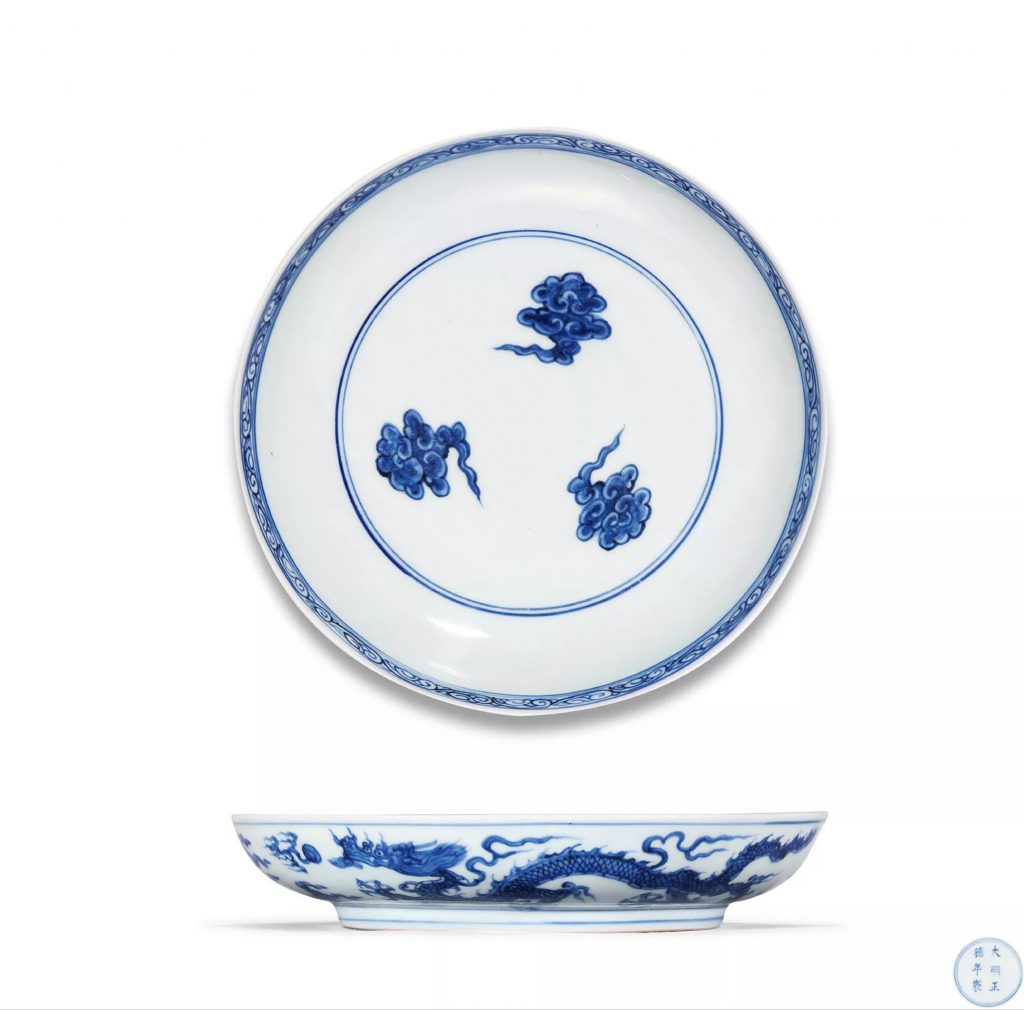
搜索
6058 明正德 青花朵云双龙纹盘
尺寸 直径22.5cm
作品分类 陶瓷 明代青花瓷器
创作年代 明正德
估价 RMB 1,200,000-2,200,000
成交价 RMB 3,105,000 HKD 3,661,557USD 465,750EUR 341,550
《玫茵堂中国陶瓷》,康蕊君,伦敦,1994-2010年,卷2,编号687
「大明正德年制」款
说明 盘撇口,浅弧腹,圈足,通体罩施白釉,釉质滋润,釉面匀净,微泛淡青色。内外壁皆以青花为饰,发色淡雅,浓淡相宜。盘心双圈内饰三朵灵芝形云纹,口沿装饰一周卷云纹;外壁饰双龙赶珠图样,双龙作追赶之状,雄姿遒劲,威势凌人,气夺千里。外底双圈内书「大明正德年制」双行六字楷书款,字迹工整,结构清秀而笔力内蕴。其「德」字书写颇有特色,心上无横,也为此一时期官窑款识书写特色。
如本品外壁描绘双龙赶珠纹样,盘心描绘品字形云纹,于洪武一朝既有烧造,并延烧至万历时期。据《明太祖实录》记载:「甲申,上入婺州……城未破先一日,有五色云见城西,氤氲如盖,城中望之以为祥及城下,乃知为上驻兵之地。」并于实录中数次记载五色祥云,皆为「圣德」所致,是为祥瑞之兆。故而祥云成为有明一代新样之吉祥纹饰延烧不绝。同类器物北京故宫博物院所藏明正德青花云龙纹盘与本品纹饰、器形、款识等特征均基本相同(参见《故宫博物院藏文物珍品大系—青花釉里红(中)》,页65);天津博物馆此类正德款青花云纹盘也有入藏(参见《天津博物馆藏瓷》,图73);同书也收录了洪武年间同类器(参见图44)。此种类型盘1964年于南京明故宫遗址亦有出土。另有宣德年代例证(可见《赵从衍家族藏明清瓷器特展》,图15)。
备注
瑞士玫茵堂收藏
参考:青花云龙纹盘



青花云龙纹盘,明洪武,高3.2cm,口径14.4cm,足径8.8cm。
盘撇口,弧壁,圈足。内外青花装饰,内底双弦纹内绘三朵“品”字形排列的云纹,里口边绘卷草纹,外壁绘云龙纹。圈足内施白釉。无款识。
此器胎质精细,胎体厚重,釉面莹润,青花色泽浅淡,少有晕散,纹饰中分散着极其明显的深色小星点,这种小黑斑的特征与元代和明永乐时的青花器常见的块状黑斑有所不同。值得一提的是,此盘内壁釉下模印云龙纹,延续了元代卵白釉瓷器的装饰风格。
参考:青花云龙纹盘

徐湖平 主编;程晓中 著.青花瓷.济南:山东科学技术出版社.2000.
参考:明洪武 青花模印云凤纹盘

拍品信息估价220,000至280,000成交价–类别陶瓷 作者 暂无 年代明洪武规格直径13.1cm预展时间2014-09-19 09:00–2014-09-21 09:00预展地点北京千禧大酒店三层财富2厅拍卖公司北京中汉拍卖有限公司拍卖时间2014-09-22 拍卖会名称犹珍18—中国古代瓷珍暨工艺品残器专场拍卖会拍卖会专场犹珍18—中国古代瓷珍暨工艺品残器专场拍卖地点北京千禧大酒店三层财富2厅拍品描述说明 说明:明洪武二年朝廷在景德镇始置御窑厂,拍品即为明洪武年间景德镇御窑厂烧制的一件典型器,洪武朝瓷器一般以青花釉里红大器最为多见,且此类盘多饰龙纹,青花模印凤纹者极为稀少,殊为珍贵。 盘心以青花绘品字云一朵,内壁模印云凤纹一周,版模清晰,外壁以青花绘云凤纹,舒展洒脱。胎体轻薄,釉色青白,青花发色深沈,浓艳处有黑色结晶斑点,器底露胎,呈现斑驳不均的赭色斑点,即所谓“米糊底”,具有典型的洪武时期特征。原北京光华路五号艺术馆馆藏有一只明洪武青花模印凤纹碗,其纹饰风格与拍品相类,可作参照。 参阅:《北京光华路五号艺术馆馆藏陶瓷》,北京光华路五号艺术馆,2009年,页164、165
参考:缠枝花卉如意云纹青花盘(明代洪武)


洪武时期瓷器的特点
1、造型特征
洪武瓷的造型,多少具有元枢府窑古朴浑厚的遗风,尤以民窑为甚。民窑撇口盘、碗类,中腰以下胎体渐厚重,有的和元瓷一样,或折腰、或器心留有叠烧的垫饼痕迹。官窑器则锐意创新,迅速摆脱元瓷厚重粗笨的风格,孕育着以造型秀美飘逸著称于世的永乐瓷雏型,从而展现了明瓷的新风貌。
2、胎体特征
胎土因淘炼粗细之差,胎质表现不一。以官窑器物而论,瓷化程度较高,因而坚致细白,稍有厚重感。民窑器物则因火力不足,有类似浆胎的现象,胎体断面呈土黄色,但大多数仍为略含杂质的浅灰白色。
3、釉面特征
釉面呈青白色,为元、明两代瓷的共同点,只是青白程度各朝略有差异。如果能把深浅不同的青白度标样总结出来,利用色标来断代,就无异于化学反应中测定ph值时所用的试纸和比色标板,既科学又简便。
常见的洪武民窑瓷器,有的胎体淘炼不精,胎质呈白或灰白色,经厚润的青白釉汁映视,釉面显示出较明代其他各朝更加深的青灰色或灰白色,而官窑器釉面也为青白色,却较民窑器白润肥厚,有的釉面伴有细碎无色的自然开片纹,玻璃化程度高,色泽清雅,柔和悦目,一般底足刷有白釉浆,薄处泛黄,厚处呈乳白或青色,光泽感不强,有器足与器身釉面色调不一的怪异现象,究其原因,或者是器足受火向背不同,熔融时产生变异,或者是底足涂了不同的釉料所致。
4、图案纹饰特征
明代早期纹饰,大多简练流畅,豪放生动。洪武时,官窑与民窑发展进程不一。官窑器的纹饰精细秀丽,或多或少流露出元代风格。而民窑的器物则别有洞天,特别是描绘自然的写实纹饰,更能体现制瓷工匠丰富的创造力,反映劳动人民丰富多彩的生活气息。
分析洪武官窑的典型纹饰,可以洪武官窑红彩龙纹盘为例。龙纹兼具元、明两代龙纹特征,但其形象不如元龙凶猛;爪为五爪;流云的云脚粗短(元代较长),盘中心的三朵流云呈“品”字形排列,这种呈品字排列的如意状云纹,沿用到正德年间都无大的差距,甚至嘉靖、万历时才有较大的变化。
洪武时所绘菊花呈扁椭圆型,折枝或缠枝莲叶纹大都呈螺丝状,而常见的元代缠枝莲叶纹为葫芦形,同时元代叶形较大,为大花大叶,至洪武时明显缩小,昔日的硕叶纹饰不复再现。由此可见看出元、明两代纹饰上的继承和演变关系。
瓷器上的那种一面青花绘画,另一面模印凸花的两面装饰法,是明代洪武窑对元代枢府窑模印花技术的承袭和演变。这一装饰工艺,成为洪武瓷器脱胎于元瓷的又一明证。
一些民窑器物的绘画也和元代纹饰一样,多用莲瓣纹图案,元代的莲瓣内常画八宝之类,而洪武时则多绘团花图案,碗、盘类,多见如意状飘带云、火云、缠枝莲等纹饰。民窑器心,多草书“福”、“寿”字,也有绘焦叶、缠枝莲、松、竹、梅、兰、水藻及人物、动物等。主题纹饰常用云龙、梅、兰、树、花草、缠枝花等,而边饰则多为二方连续简单几何纹。
民窑青花器纹饰,继承传统的书法与绘画,制造了明代早期的“一笔点划”,用笔简练、纯熟,以描写自然为主,样式无华,大笔写意,着意渲染,青花色调与元代一样,比较稳定,很少有流散现象。但发色并不浓重,过于清淡,能较好地烘托出纹饰画意。
5、底足特征
洪武瓷器底足中心乳钉状突起,是元代器足的遗风。这种器足处理,在当时处于主流地位,成为明显的时代标志。同时也兴起各种型的圈足,种类繁多,常见的有圆涡形厚足、高足。另外,青花碗一类,则底面无釉,圈足深高,有的足过肩,残留有削痕及同心圆跳刀痕。前面谈到的列为洪武官窑的那件外酱釉霁蓝暗花凸云大碗的残底,为浅圈足,与宣德斜削浅圈足微有区别,元、明两代瓷器的砂底,露胎处可见星黑点状或人片的火石红斑。其形成原因有两种;一为胎本身含有铁质,经窑火烧结转为氧化铁而早现红色;另一为工匠着意律刷而成。这种自然与人为而成的火石红斑,至元代始多见,经明代延续到清代中叶,乾隆以后才完全消失。通常是火石红斑越浓重,表明器物做的年代越早;但景德镇制陶业几经钻研,近年已初步掌握了使砂底露胎处呈现火石红斑的技术。
洪武正处于元、明交替之际,是一个承上启下、继往开来的重要时期。这一时期的瓷器,截止目前已有相当数量的传世品与地下发掘物可供研究。
参考:
中国嘉德国际拍卖有限公司
香港2016年春季拍卖会
观古—瓷器珍玩工艺品(二)
Lot:985 明弘治 青花云龙纹盘
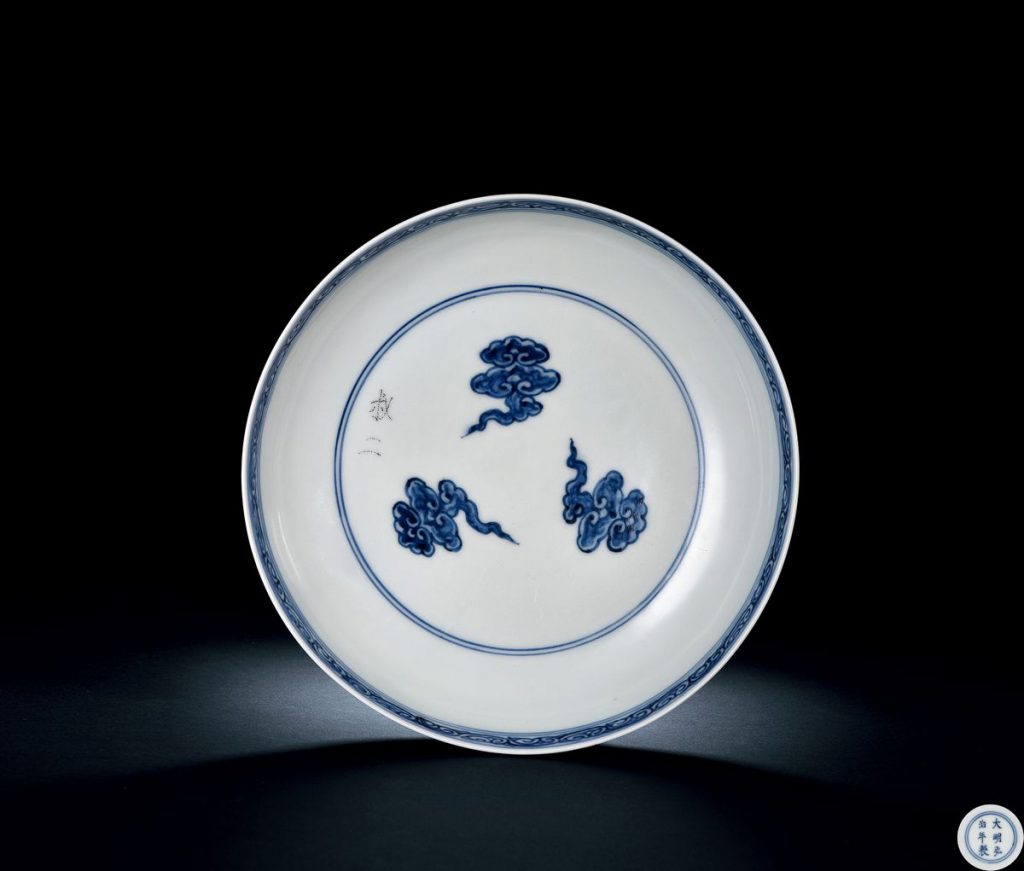
估价:HKD 1,500,000-2,500,000
成交价:-
尺寸:直径21cm
描述:“大明弘治年制”六字二行楷书款,弘治本朝弘治御窑瓷器传世极少,独树一帜,乃朱明御窑之旷世隽品,极负盛名。皆因深谙治世之道的明孝宗,他励精图治、任用贤臣、主张节俭、与民休息,遂成“弘治中兴”之世。综观孝宗当政十八年,曾前后六次敕令官窑停烧,经常“禁内府加派供御物料”、“减供御物品”、“罢营造器物”、“减光禄寺供应”等,并召回督造内官,例如《明史?本纪第十五孝宗》记:“弘治三年冬十一月甲辰,停工役,罢内官烧造瓷器。”故弘治一朝窑业数量稀少,罕有创新,虽少尤精。本品即属明代中期宫廷御瓷之代表性器物,流传至今,其珍贵稀少由此可见一斑。
此制式龙青花云龙纹细腻生动,设色淡雅脱俗,既有别于永宣之恢弘壮阔,亦不似嘉万之典雅稚拙。盘敞口,弧腹,圈足。通体以青花为饰。盘心双圈内绘灵芝状云纹三朵,旁后刻“叔二”款,口沿下一周忍冬纹。外壁饰一对行龙赶珠,精到有神,雄姿遒劲,气夺千里,威势凌人。底青花双圈内书“大明弘治年制”六字二行楷书款,结构清秀而笔力内蕴。
若本品者内心绘品字形云纹,外壁描绘双龙赶珠纹样的青花盘早在洪武朝就有烧制,并延续制万历时期。其釉色浓淡相宜,雅致清新;釉汁丰腴凝腻;胎骨坚致细薄。然其时距成化一朝未远,通体效果水平极高,所出之物皆能秉承成窑品格,几与成窑鼎盛时期作品难分伯仲,故古人谓之“成弘不分”。
本品是为当今弘治朝仅见之器,市场上曾出现过正德朝所制类器:香港苏富比2011年春季拍卖会释出的第3200号明正德青花双龙争珠纹盘,成交价高达7,460,000元港币;另在北京故宫博物院和天津市艺术博物馆均有正德款的类似藏品,均可论较相玩。
参阅:
《故宫博物院藏文物珍品大系:青花釉里红(中)》,上海科学技术出版社、商务印书馆(香港),2000年,第65页
《中国美术分类全集:中国陶瓷全集·第12卷·明(上)》,上海美术出版社,2000年,第134页,图136(天津市艺术博物馆藏品)
《世界陶瓷全集14·明》,小学馆,1976年,图6667

弘治御窑瓷器传世极少,独树一帜,乃朱明御窑之旷世隽品,极负盛名。皆因深谙治世之道的明孝宗,他励精图治、任用贤臣、主张节俭、与民休息,遂成“弘治中兴”之世。综观孝宗当政十八年,曾前后六次敕令官窑停烧,经常“禁内府加派供御物料”、“减供御物品”、“罢营造器物”、“减光禄寺供应”等,并召回督造内官,例如《明史‧本纪第十五孝宗》记:“弘治三年冬十一月甲辰,停工役,罢内官烧造瓷器。”故弘治壹朝窑业数量稀少,罕有创新,虽少尤精。本品即属明代中期宫廷御瓷之代表性器物,流传至今,其珍贵稀少由此可见一斑。
此制式龙青花云龙纹细腻生动,设色淡雅脱俗,既有别于永宣之恢弘壮阔,亦不似嘉万之典雅稚拙。盘敞口,弧腹,圈足。通体以青花为饰。盘心双圈内绘灵芝状云纹三朵,旁后刻“叔二”款,口沿下一周忍冬纹。外壁饰一对行龙赶珠,精到有神,雄姿遒劲,气夺千里,威势凌人。底青花双圈内书“大明弘治年制”六字二行楷书款,结构清秀而笔力内蕴。
若本品者内心绘品字形云纹,外壁描绘双龙赶珠纹样的青花盘早在洪武朝就有烧制,并延续至万历时期。其釉色浓淡相宜,雅致清新;釉汁丰腴凝腻;胎骨坚致细薄。然其时距成化一朝未远,通体效果水平极高,所出之物皆能秉承成窑品格,几与成窑鼎盛时期作品难分伯仲,故古人谓之“成弘不分”。
本品是为当今弘治朝仅见之器,市场上曾出现过正德朝所制类器:香港苏富比2011年春季拍卖会释出的第3200号明正德青花双龙争珠纹盘,成交价高达7,460,000元港币;另在北京故宫博物院和天津市艺术博物馆均有正德款的类似藏品,均可论较相玩。
参考:藏品名称:明代成化青花双龙赶珠纹盘
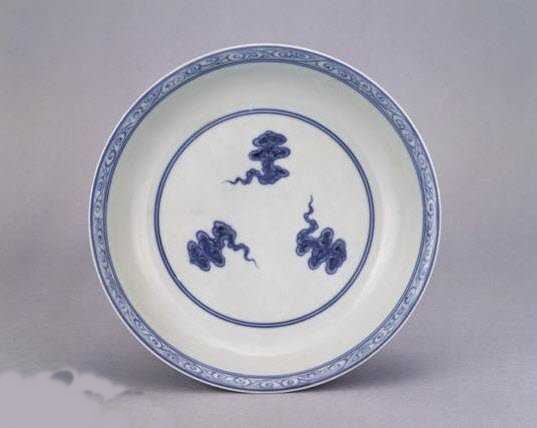
藏品名称:明代成化青花双龙赶珠纹盘
鉴定鉴赏:侈口窄唇,浅壁,圈足。以釉下青花绘饰,外壁绘双龙戏珠,间饰十字云纹。盘内口缘画卷草纹一週,内壁素白无纹,盘心画如意云纹三朵。底青花书「大明成化年制」双圈六字楷款。
博物馆名:台北故宫博物院藏品。
估价价格:馆藏珍品,无法估计价格。
藏品分类:瓷器
功能作用:盛装器
尺寸大小:高4.3厘米,口径20.4厘米,足径12.5厘米。
藏品年代:明成化
参考:香港蘇富比拍卖有限公司
中国瓷器及工艺品
2011年春季拍卖会 2011-04-08
明代青花瓷器
3200 明正德 青花双龙争珠纹盘
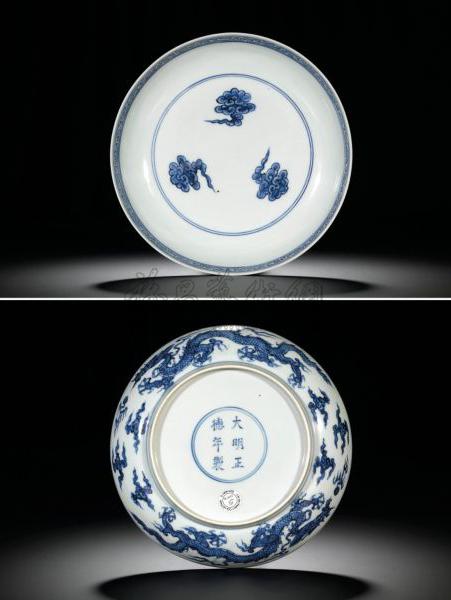
拍品信息
估价 HKD 1,000,000-1,500,000
成交价 RMB 6,281,320 HKD 7,460,000 USD 954,880 EUR 746,000
尺寸 22.4cm
参考:北京中汉拍卖有限公司
2015年春季拍卖会 2015-04-02
犹珍20——瓷器玉器工艺品专题拍卖会收藏品
0110 明正德 青花云龙纹盘

信息估价 10,000至20,000
成交价 66,700
规格直径20.5cm
描述款识:“大明正德年制”六字双行楷书款
说明:拍品器型周正,胎质细腻洁白,外壁绘五爪双龙,身形矫健,欲扑火珠。盘心青花双圈内绘三朵卷云纹,俊秀飘逸。青花发色淡雅,富含变化,为典型正德青花器。北京故宫博物院收藏有类似作品,可兹比较。 参阅:《故宫博物院藏文物珍品大系-青花釉里红(中)》,上海科学技术出版社,2000年,页65,图60
参考:伦敦苏富比2016亚洲艺术品秋季拍卖会
中国艺术珍品
清康熙 青花凤纹鼓形盖盒

拍卖信息
Lot 240 清康熙 青花凤纹鼓形盖盒
云朵画法相似
估价:6,000-8,000 GBP
成交价: 7,500 GBP (含买家佣金)
尺寸: 直径9.5cm
参考:大英博物馆 明 宣德 青花如意云盘 dish

Object typedish
Museum number 1930,0421.4
Description
Porcelain dish with underglaze blue decoration. This shallow dish and BM 1930.0421.3 have rounded sides, only BM 1930.0421.3 has an everted foot rim and both stand on tapering foot rings. Inside they are painted with a three-cloud design known as the ‘juyun’ motif within a double ring and the inner rim is decorated with a classic scroll. Outside two dragons, each pursuing a flaming pearl, chase each other among ruyi clouds. The rim, join of foot to body and foot are emphasized with single blue lines. In the centre of the convex base is a six-character Xuande reign mark in a double ring. Superficially these dishes are identical, but there is a host of minor differences which distinguish them. For example, the cobalt used for BM 1930.0421.3 appears smoother and more controlled than the ‘heaped and piled’ and blurred blue of this piece. Second, the shapes are different, one having an everted rim and this one rounded sides. Third, BM 1930.0421.3 has a whiter glaze than this dish, which has a blue-green tinge.
More
Culture/period Xuande (mark and period) Ming dynasty
Date 1426-1435
Production place Made in: Jingdezhen(Asia,China,Jiangxi (province),Jingdezhen)
FindspotFound/Acquired: China(Asia,China)
Materials porcelain
Technique under glazed glazed
Dimensions Diameter: 20.1 centimetres Height: 4.5 centimetres
Inscriptions
Inscription Type
mark
Inscription Position
base
Inscription Language
Chinese
Inscription Transliteration
Da Ming Xuande Nian Zhi
Inscription Translation
Made in the Xuande reign of the Ming dynasty
Inscription Comment
reign(Xuande)
Curator’s comments Harrison-Hall 2001:
A dish with rounded sides and the same decoration of three clouds inside but with two phoenix on a lotus-scroll ground outside is in the National Palace Museum, Taipei.
Bibliography Harrison-Hall 2001 4:35 bibliographic details
Location Not on display
Subjects flaming pearl dragon
Acquisition date1930
Acquisition notes Purchased.
DepartmentAsia
Registration number 1930,0421.4Porcelain dish with underglaze blue decoration. On the inside is a three-cloud (juyun) motif. Outside two dragon pursue a flaming pearl among ruyi clouds. Base bears a six-character Xuande reign mark.

![[临渊阁]天地一家春](https://www.antiquekeeper.ca/wp-content/uploads/2023/03/cropped-Asian-Art-Wallpaper-Painting3-6-2.jpg)

